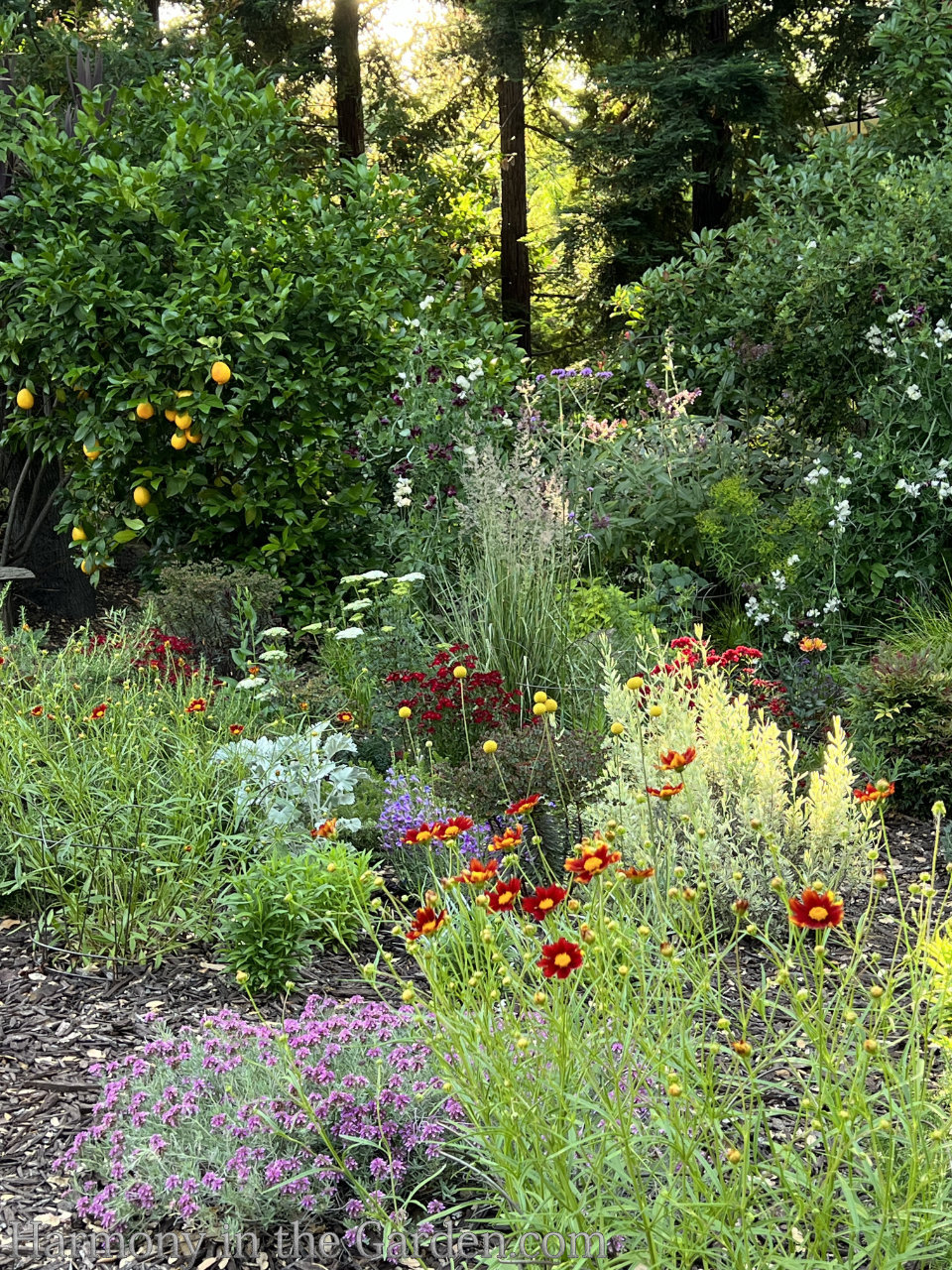
Designing a modified meadow in my new garden has been one of the most challenging yet most rewarding things I’ve ever created.
Also known as meadowscaping (a popular trend that replaces traditional lawns with a native, slightly overgrown, prairie-inspired garden), my ‘modified’ meadow fits into this category, yet with a twist – hence the ‘modified.’
After four years of trial and error, plant relocation, and experimenting with new varieties, I can finally say this went from being my least favorite to my most favorite part of the garden.
In fact, I find myself strolling through this area several times a day as there’s always something new to see.

Last week, Garden Gate Magazine visited and created a video of my garden (I’ve posted the video at the end of this post.)
Over the past few days I’ve received SO MANY requests from new blog subscribers to elaborate a bit more on how I created this garden.
I hope the following information helps!
Two Main Goals of my Meadow Garden
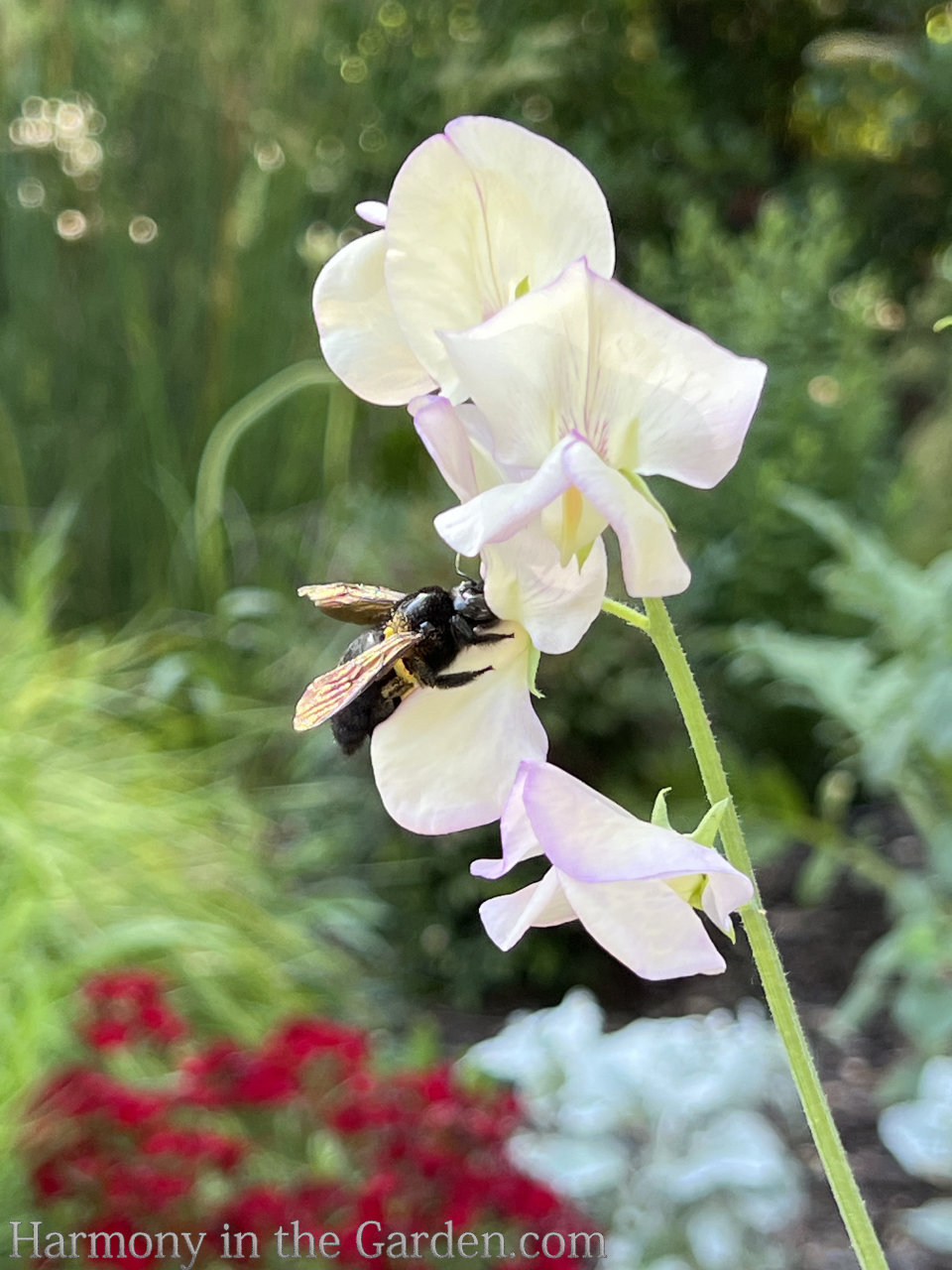
1. Attract Pollinators & Wildlife
To help increase pollinator and wildlife diversity, this part of my garden has a lot of different plant varieties.
Or, as my husband likes to point out, ‘Twice as much as is needed.‘ Hmmm…I disagree!
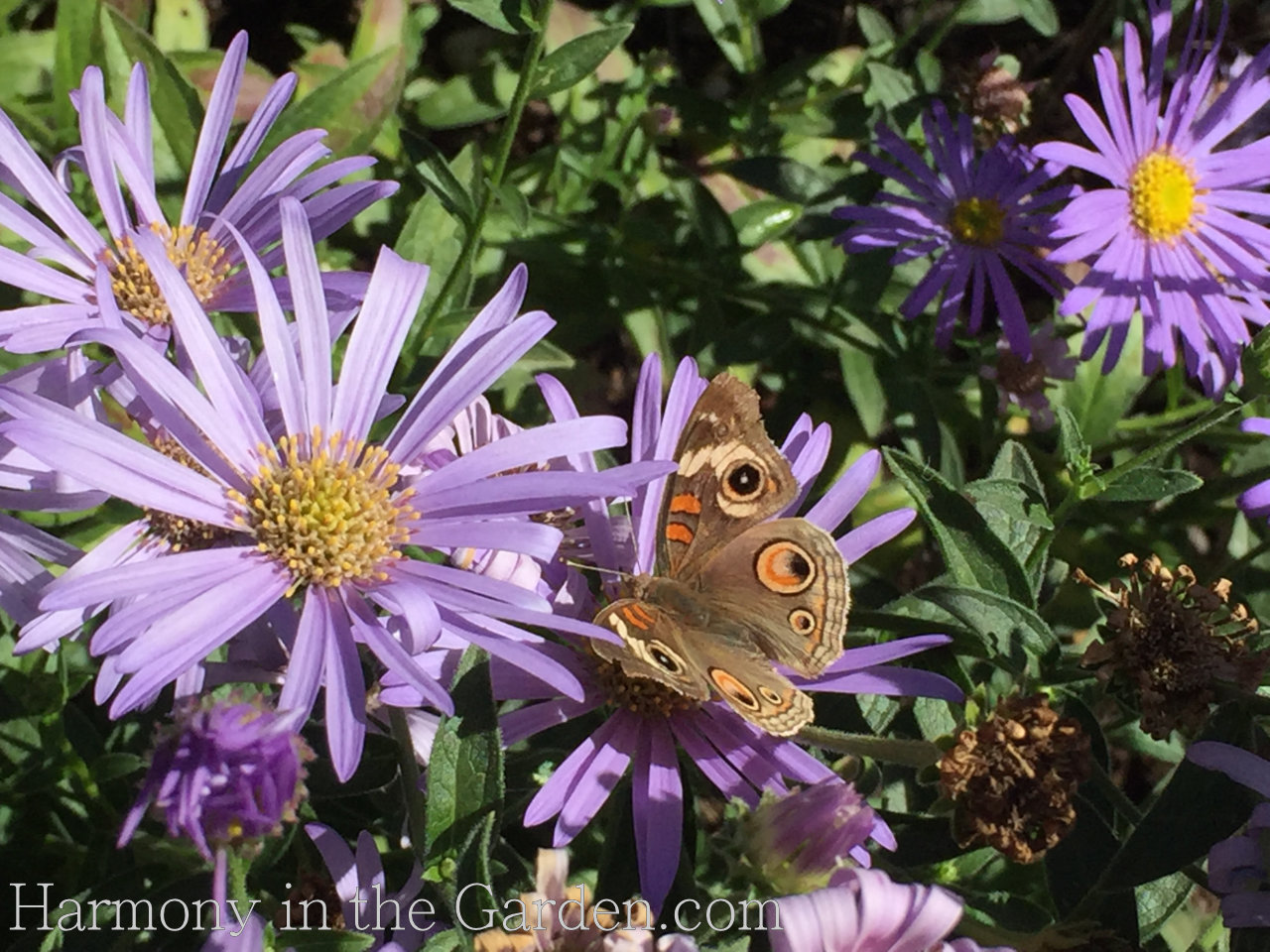

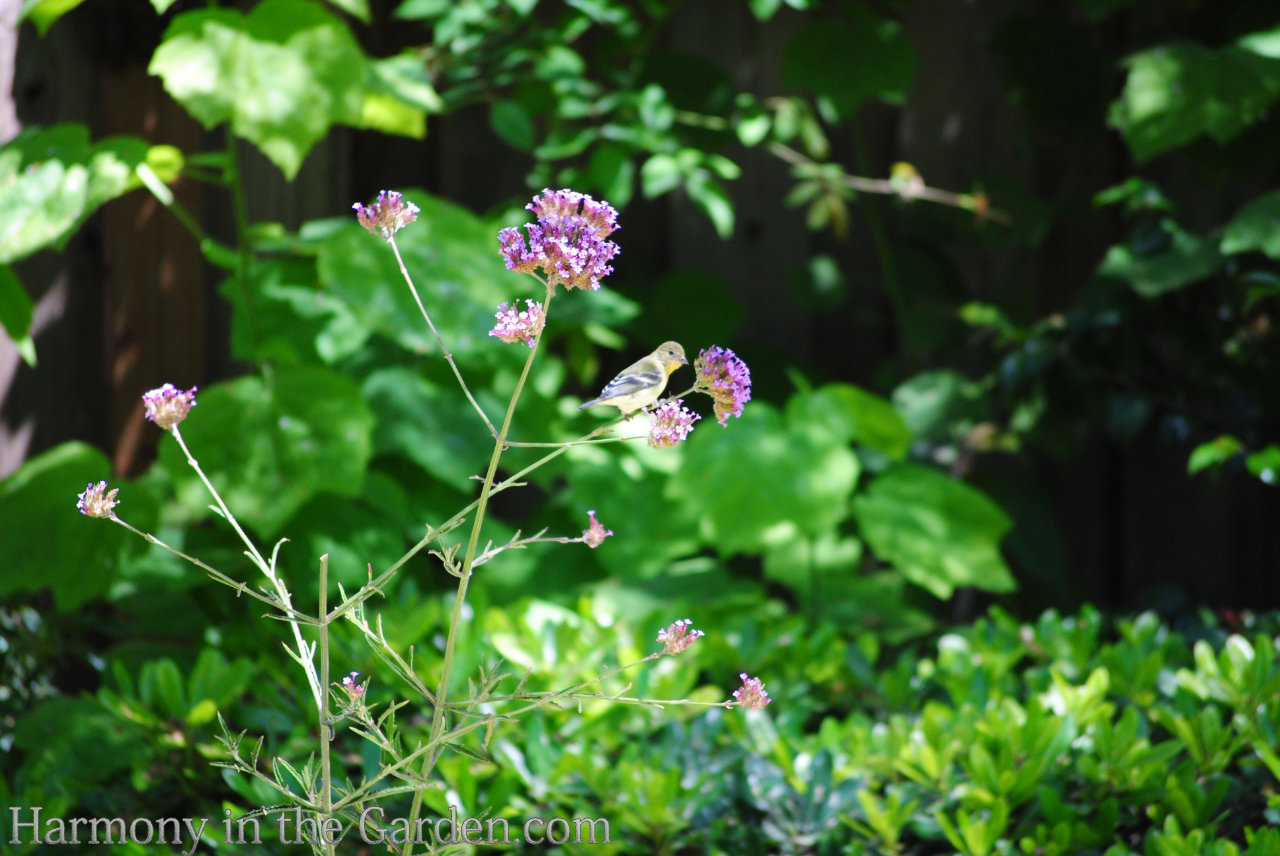

2. Capture Rainfall
Similar to a meadow, I wanted to capture and retain as much water as possible.
I created a depression at the lowest point, surrounded by a semi-circle berm, to capture and contain the rainfall. This allows the rain to slowly soak into the ground.
(For more details how I did this, plus some helpful before & after pics, click here.)
I also included a hefty dose of deep-rooted meadow plants that not only enhance the soil structure but also aid in the infiltration rate of water.
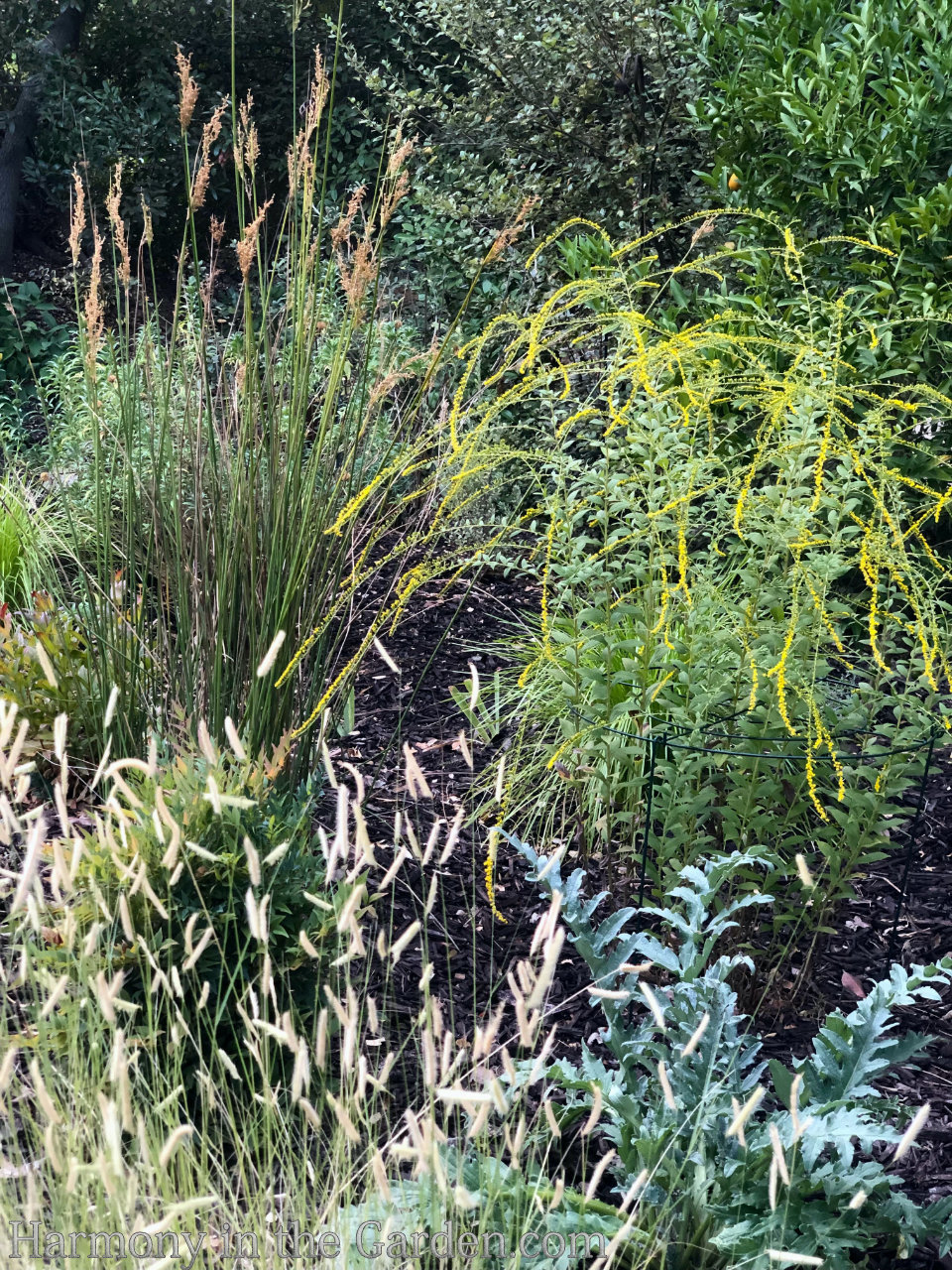
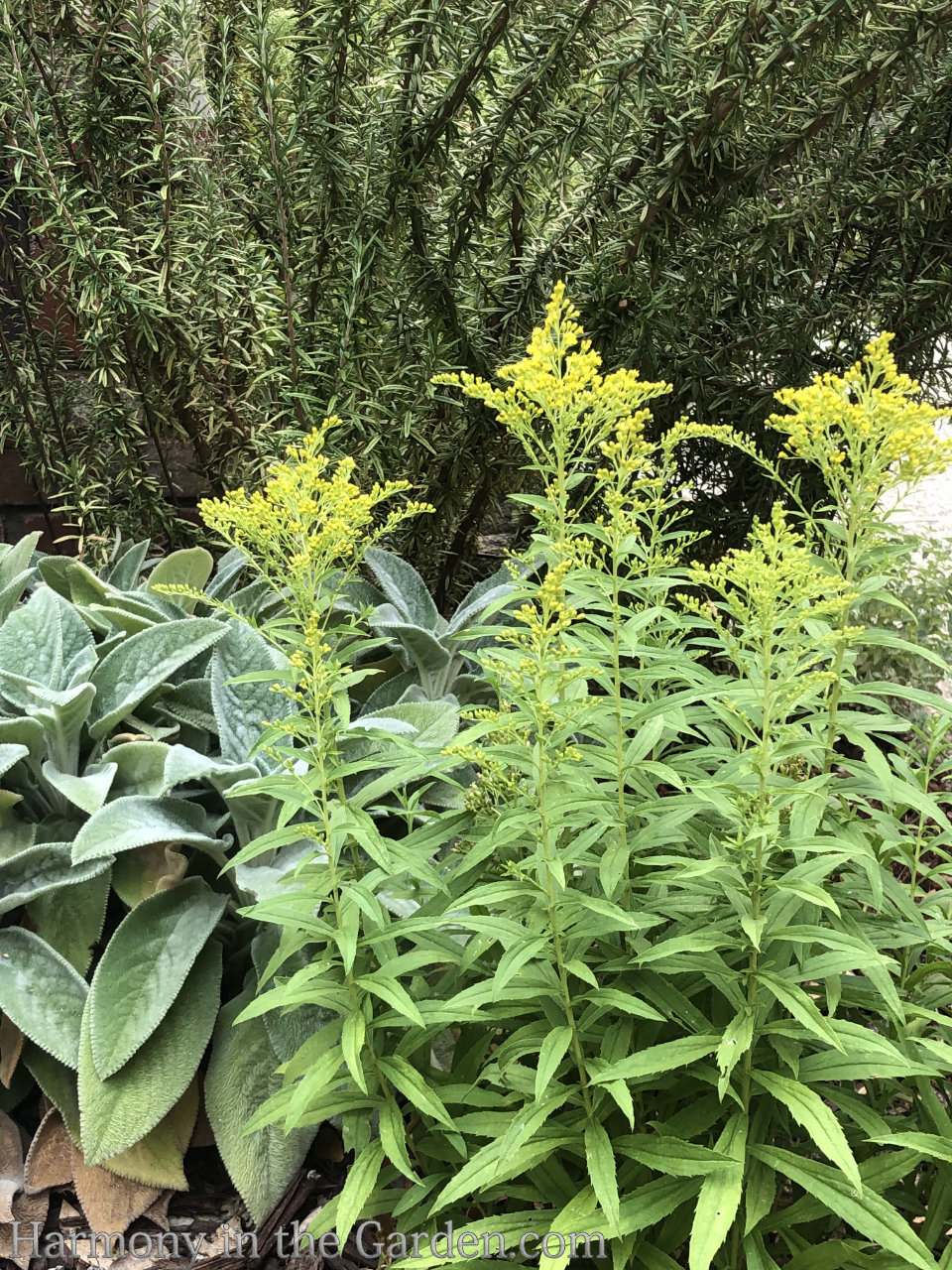
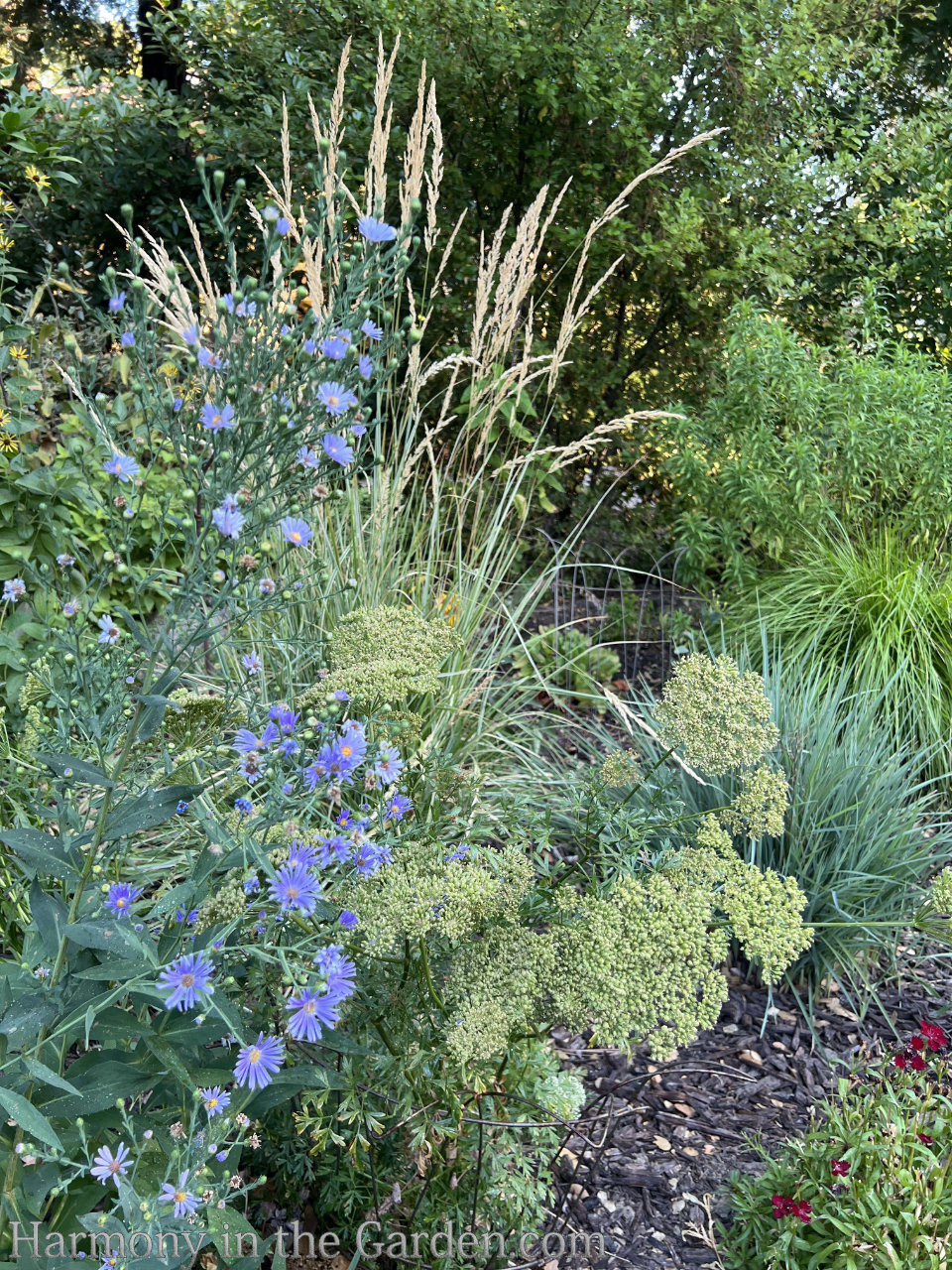
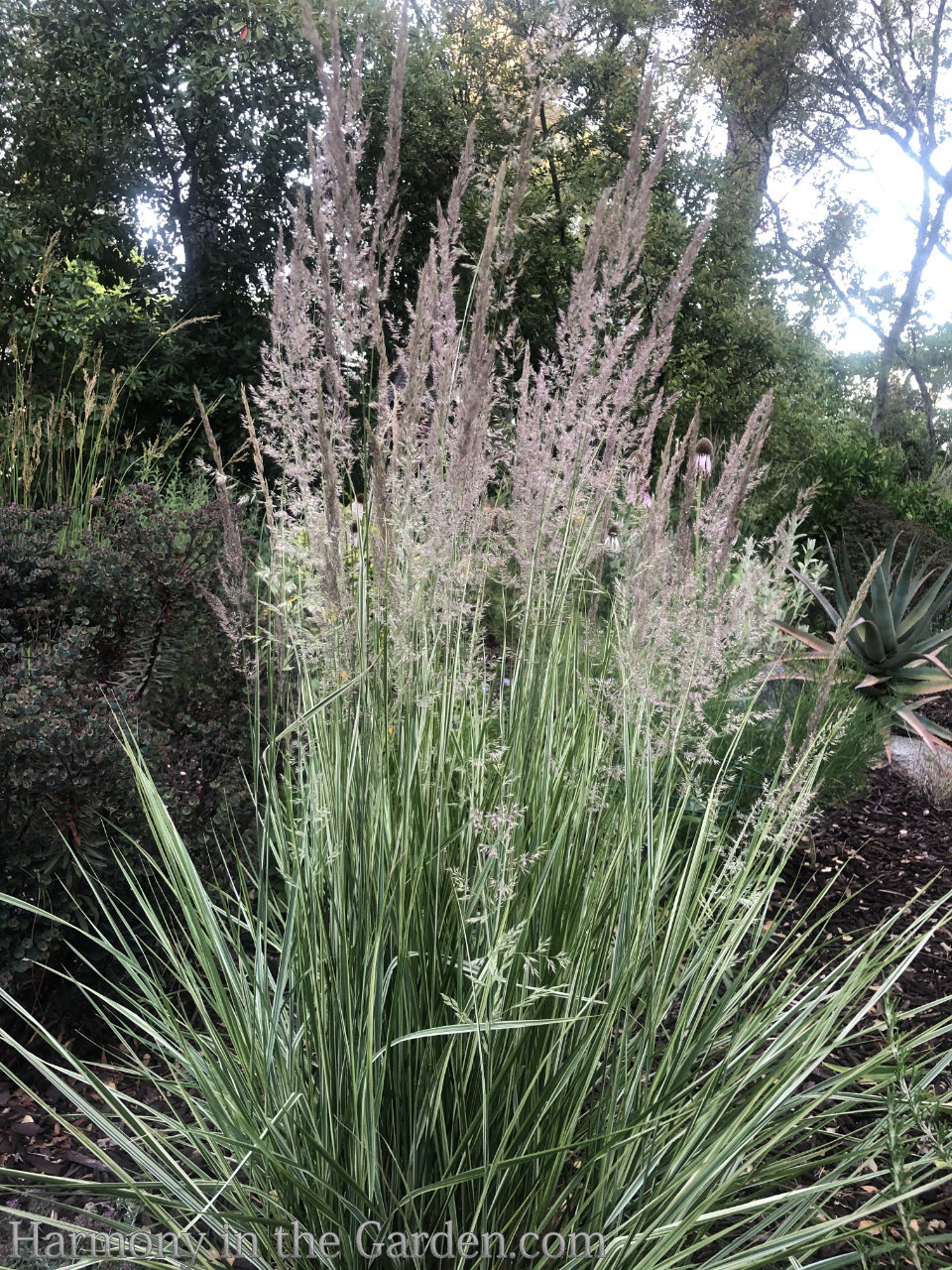
So, what makes my meadow ‘modified’?

1. Winter vs. Seasonal Interest
Meadows are traditionally seasonal, peaking in the spring and summer, then fading away in the winter.
This is to be expected, considering they consist primarily of annual grasses and wildflowers.
However, since I live in a mild-winter climate (zone 9), I wanted my garden to still look good during the winter months.
To help achieve this, I used plenty of non-traditional meadow plants, a few of which are listed below.
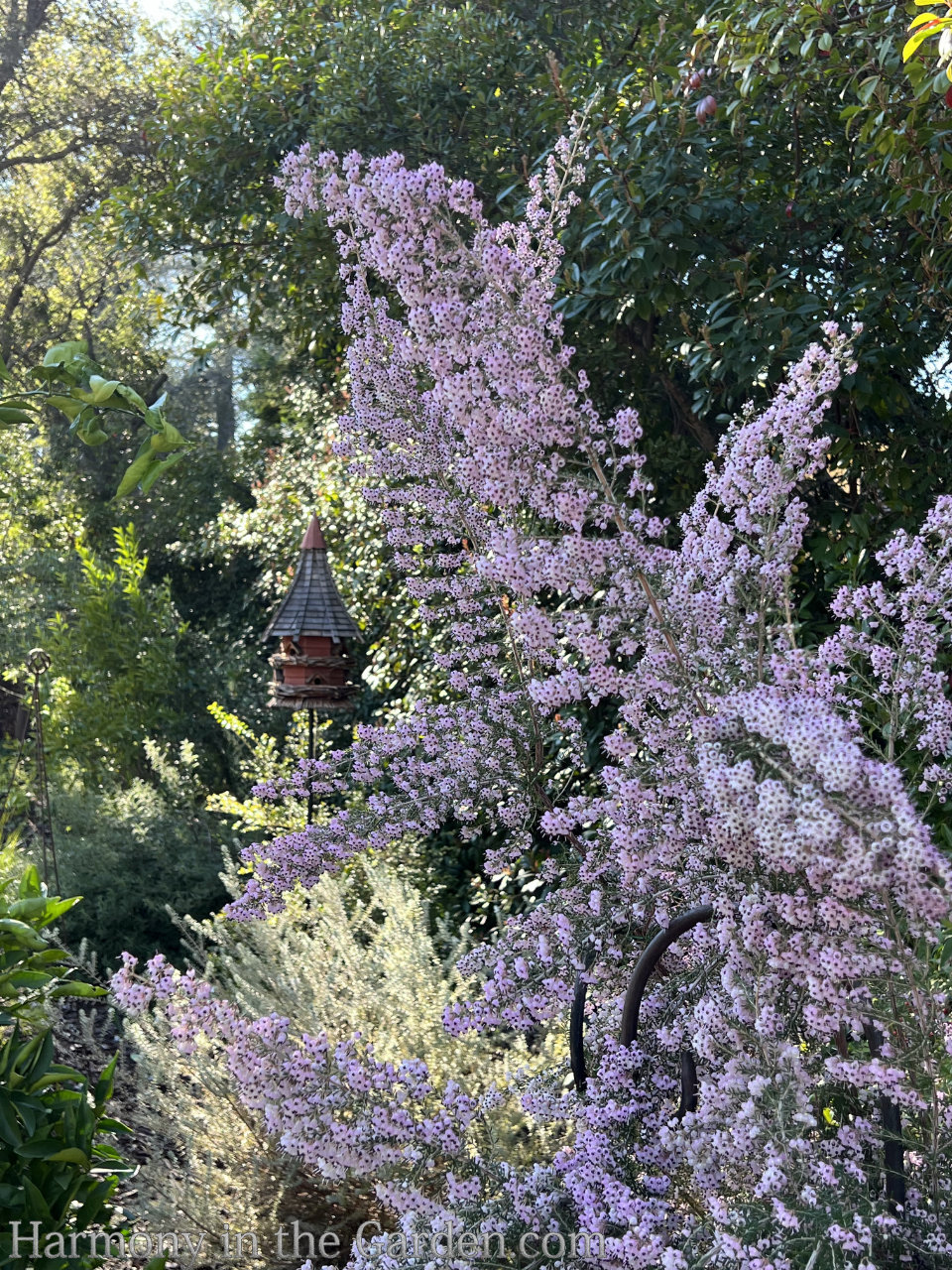

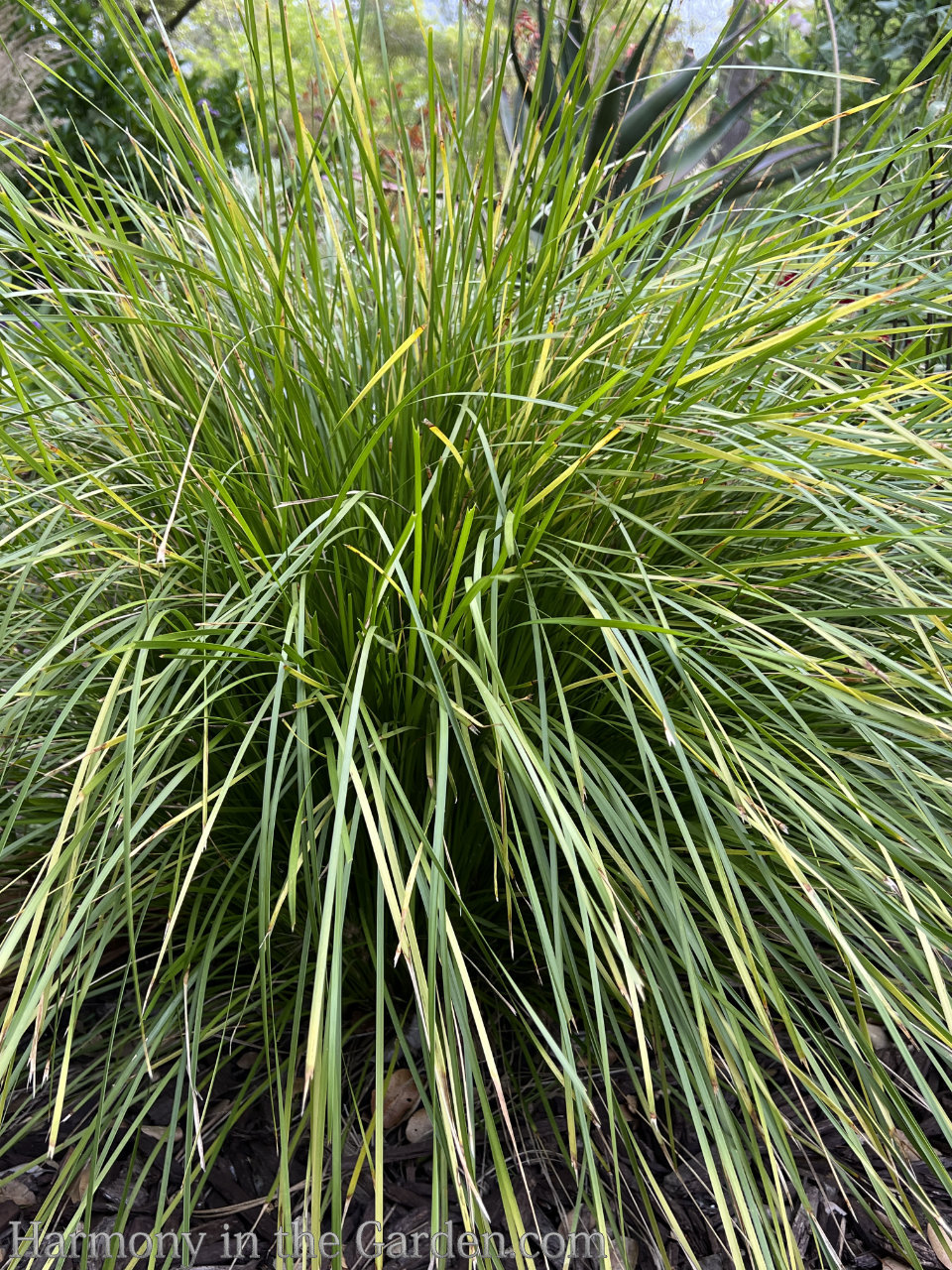
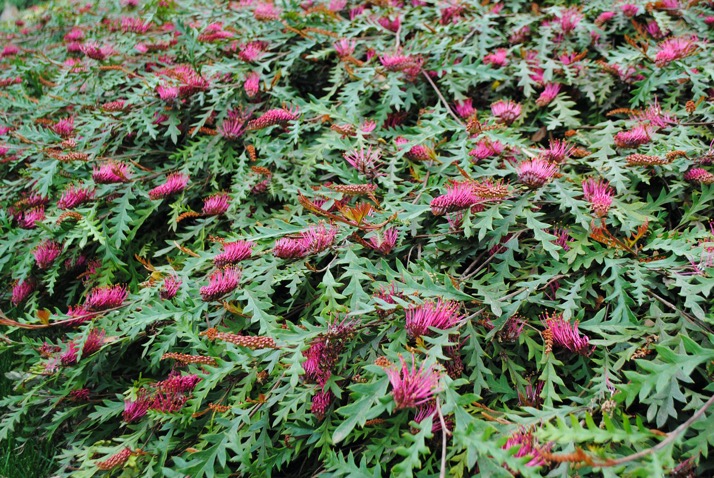
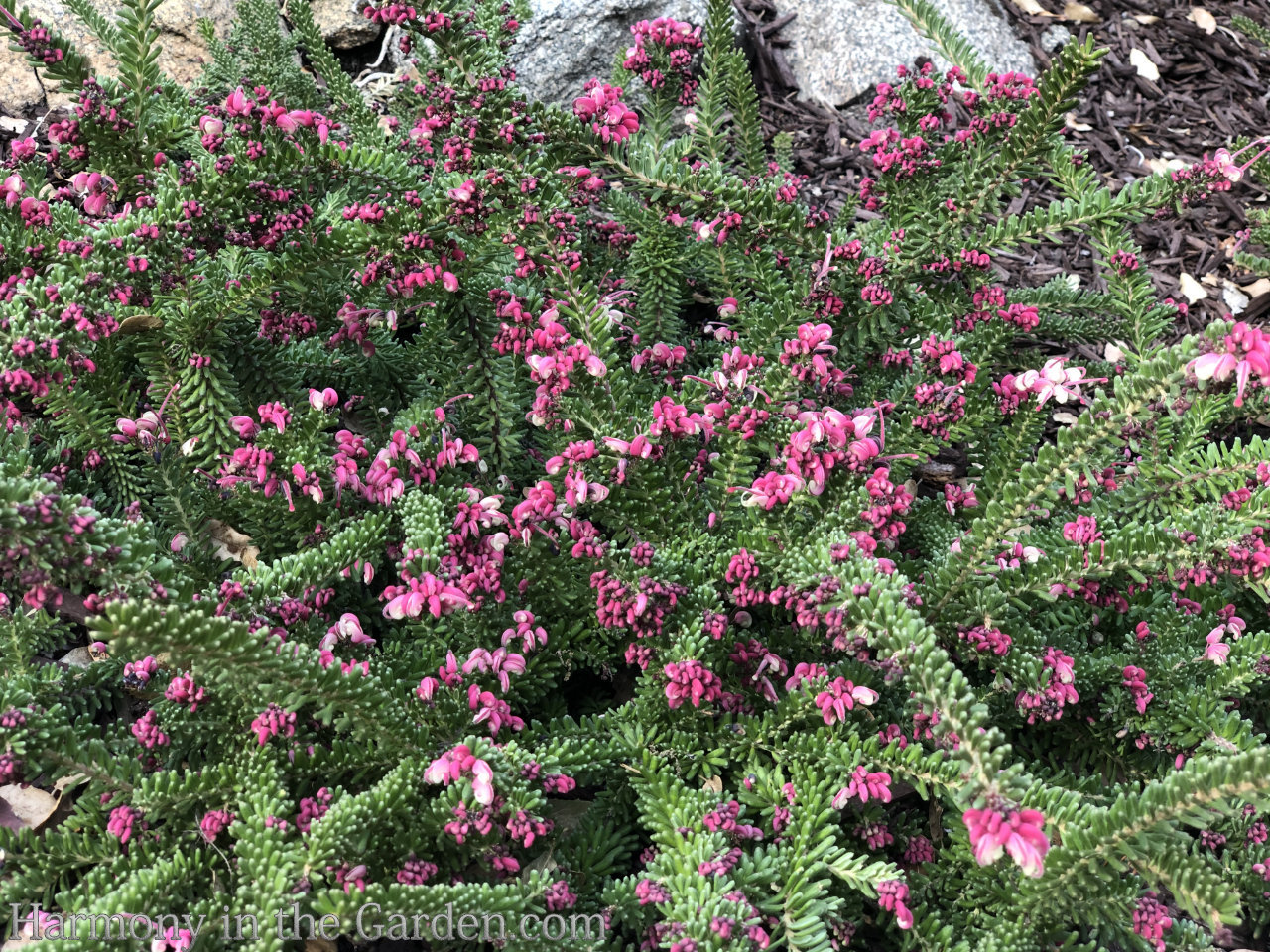
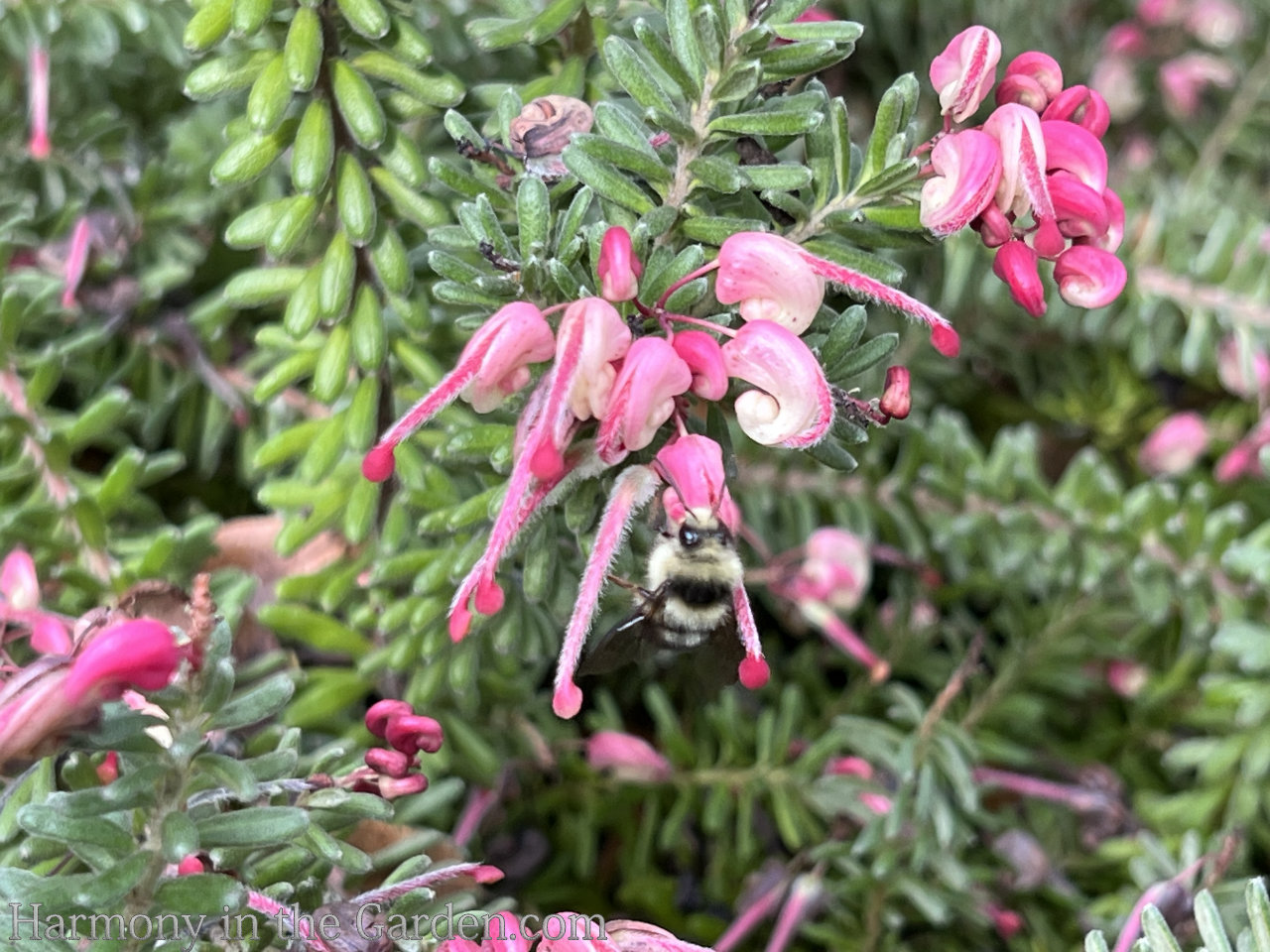
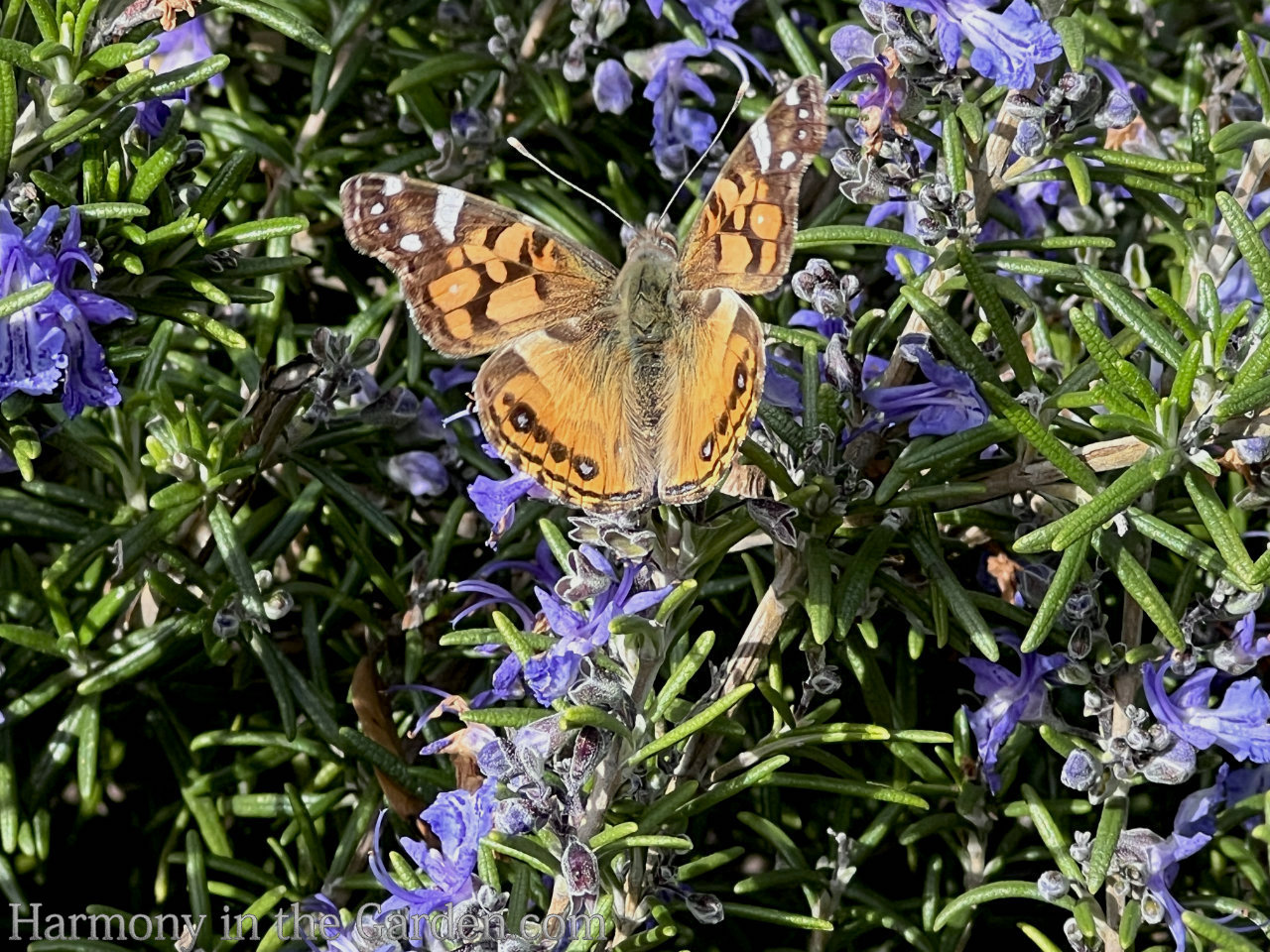
One thing I wanted to mention is the importance of providing sources of food for late-winter pollinators. I took these two photos in January, with the Black-Tailed Bumble Bee (which is one of the first to emerge!) feasting on a grevillea flower, and the American Lady butterfly devouring the blooms on my ‘Mozart’ rosemary.

2. Incorporate Seating
Even though this part of my garden is wilder looking, I still wanted to make sure it blended in with the rest of the surrounding garden.
One way to achieve this, was to create a seating area, which is something found in more traditional garden spaces.
The goal is to encourage guests to explore the meadow through informal pathways that lead to a small bench. I especially love how the concrete faux-bois bench blends right in with the garden.
An added bonus of a seating area set within the garden bed is the chance to see the garden at eye-level, resulting in feeling immersed and surrounded by the garden.

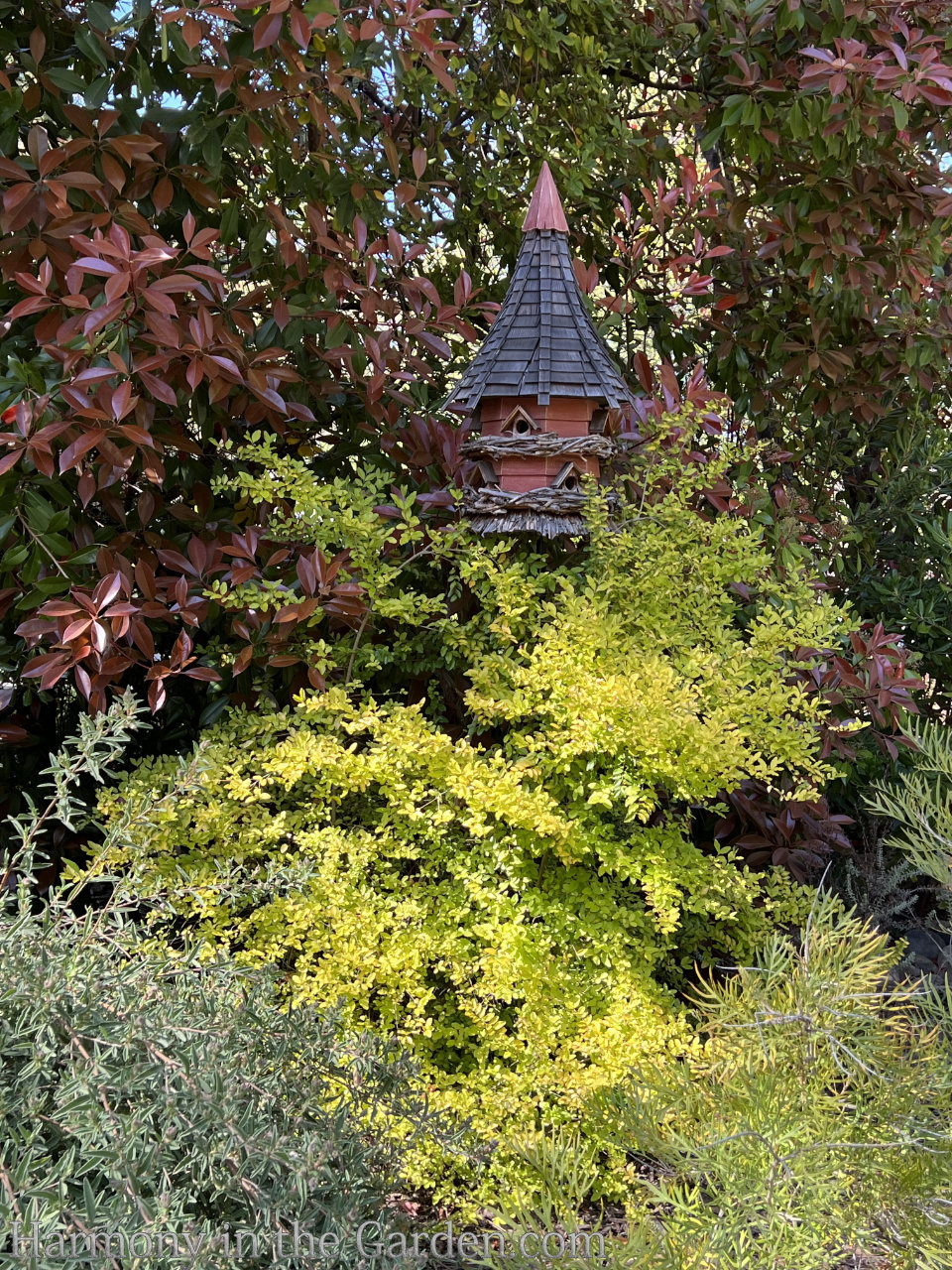
3. Add Focal Points
Several focal points are included in this modified meadow to help add year-round interest.
For example, this birdhouse (made by my good friend, Freeland Tanner) is one of my favorite focal points in this area.
And yes, birds make nests in here every spring!
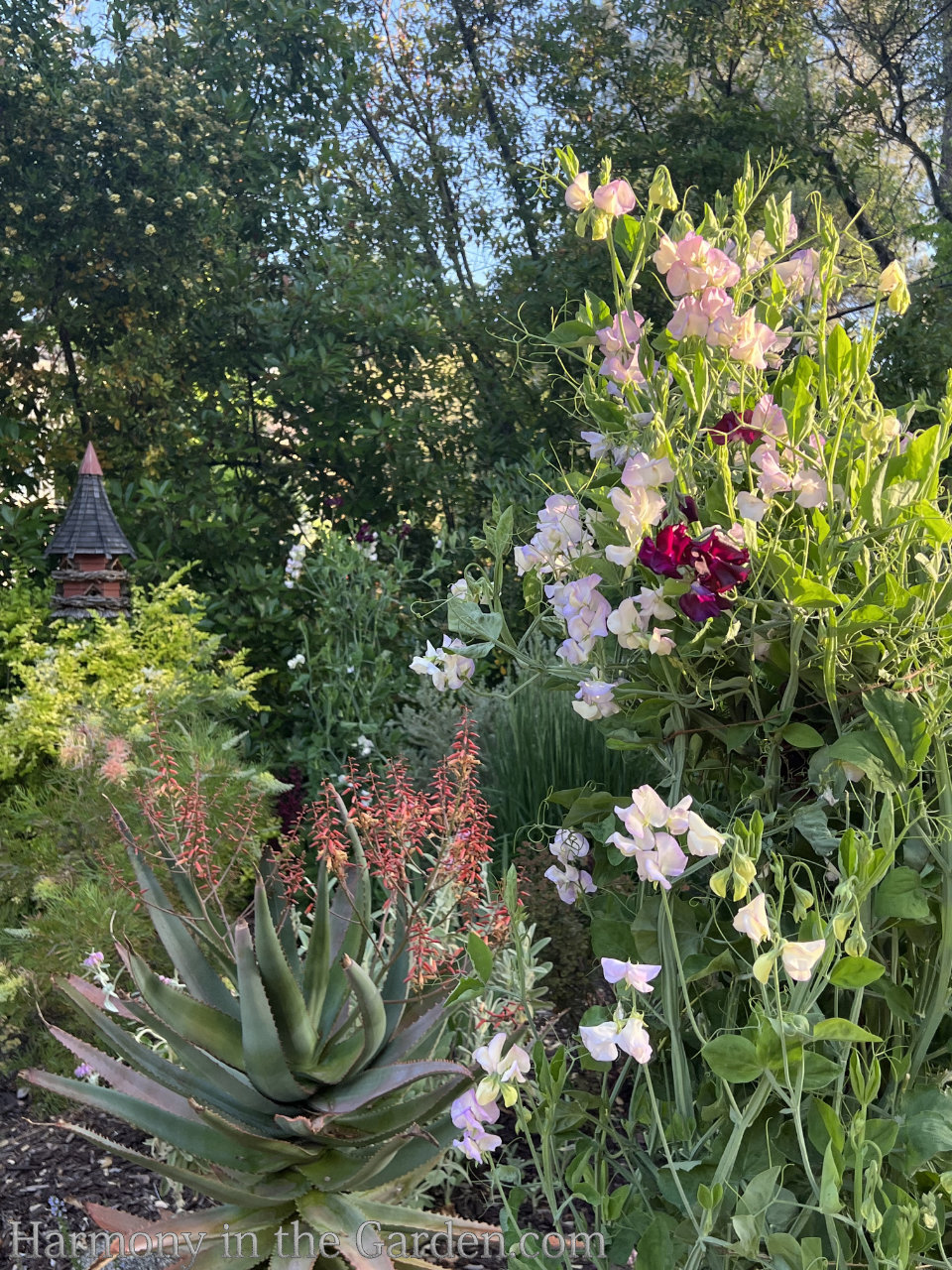
I also have three tuteurs placed throughout the meadow.
In the spring, they support climbing sweet peas that provide months of sweet-smelling blooms.
Even though it gets really hot here in the summer, I’ve had great luck with sweet peas. The trick is to plant the seeds in the fall which allows their roots to really get established before hot weather arrives.


However, once the sweet peas are finished blooming, it’s the towering perennial ‘Henry Eilers’ rudbeckia turn to grow up and through the tuteurs.
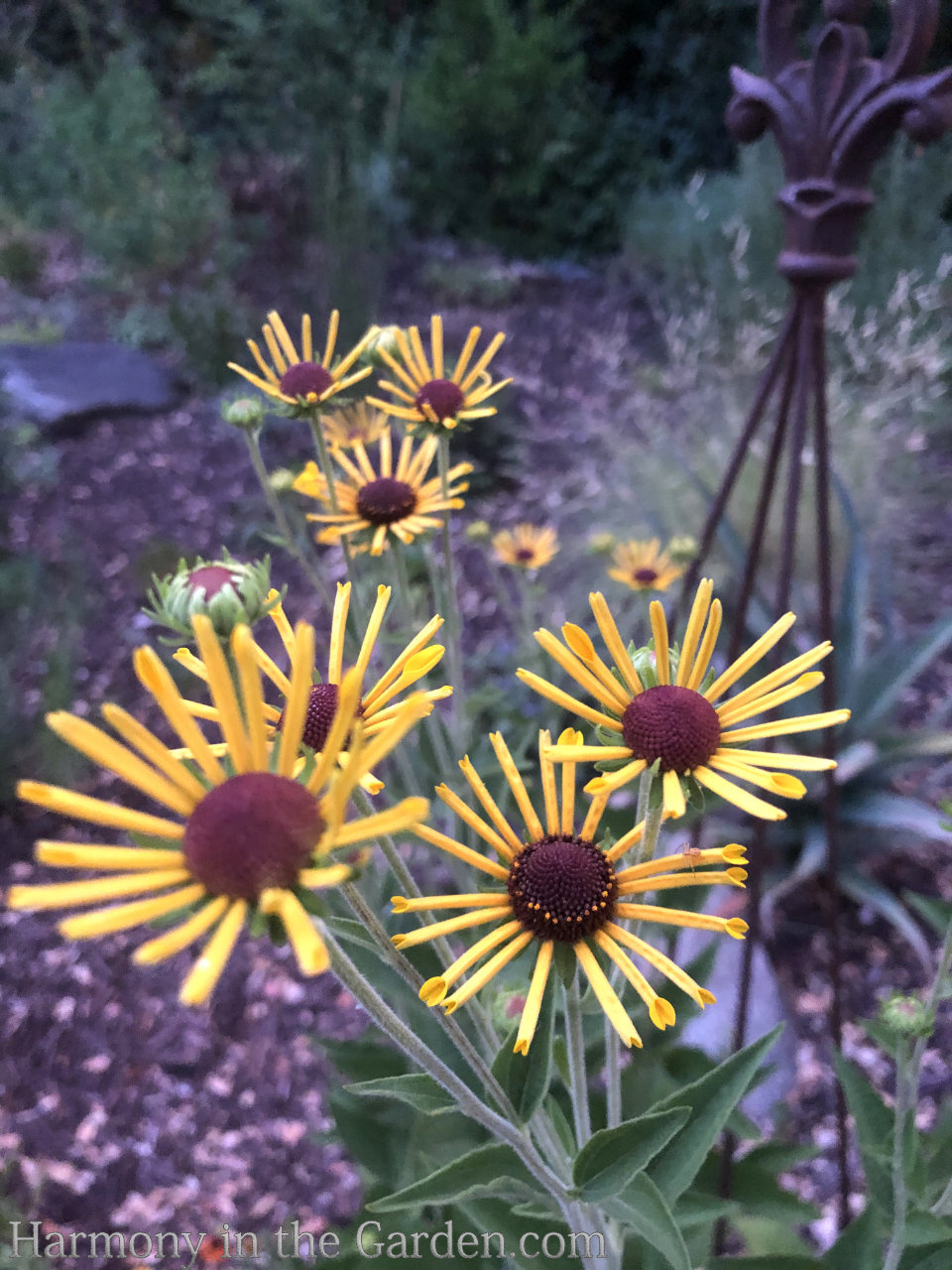

4. Unexpected Plant Selections
Typically, meadows consist of a ratio of 60% annual grasses to 40% perennials and wildflowers (some say even 70/30 – but who’s counting.)
However, when designing my modified meadow, I reversed the ratio to about 30/70, emphasizing perennials and evergreen plants over grass, to achieve year-round interest.
In addition to the reversed ratio, I focused on a combination of natives and non-natives, all of which had to be deer and drought-tolerant.
Also, when it comes to adding non-natives to my garden, they need to be non-invasive, adaptable to our area, and provide some sort of benefit for wildlife (whether it’s food, shelter, seeds, or building material for their nesting.)
Here are a few of my favorites:
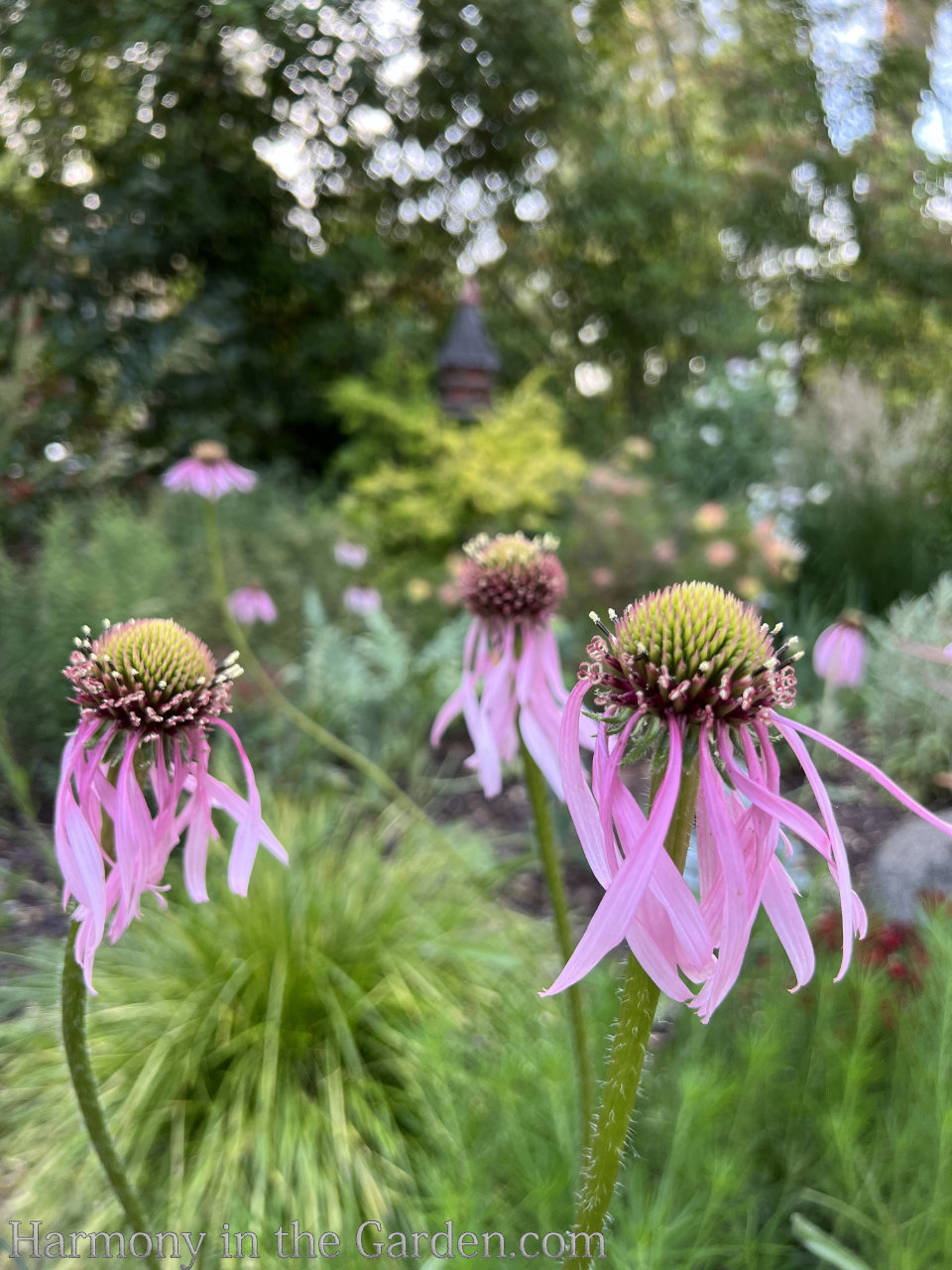

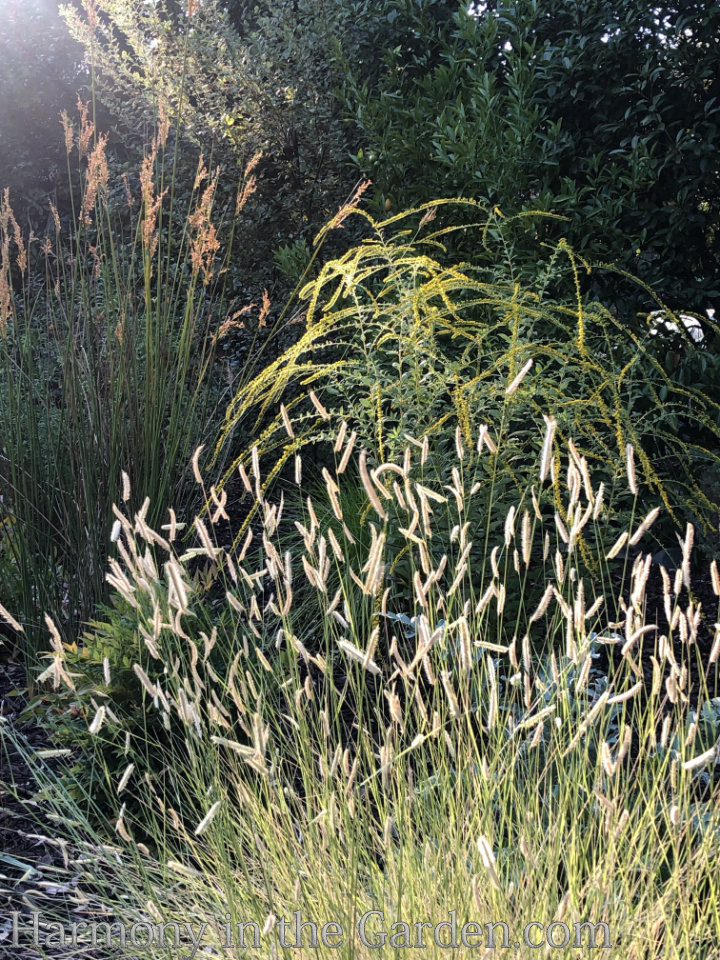
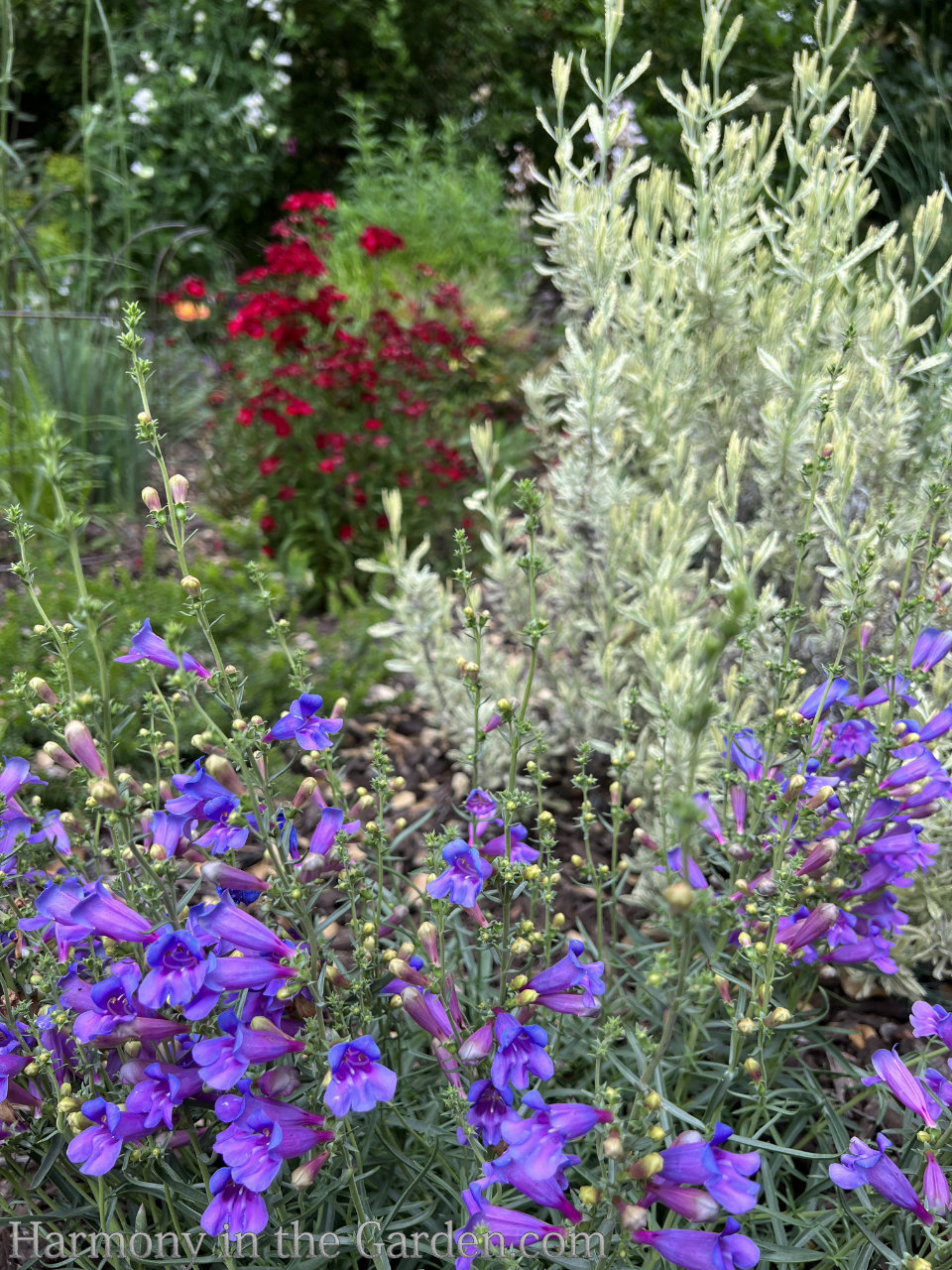
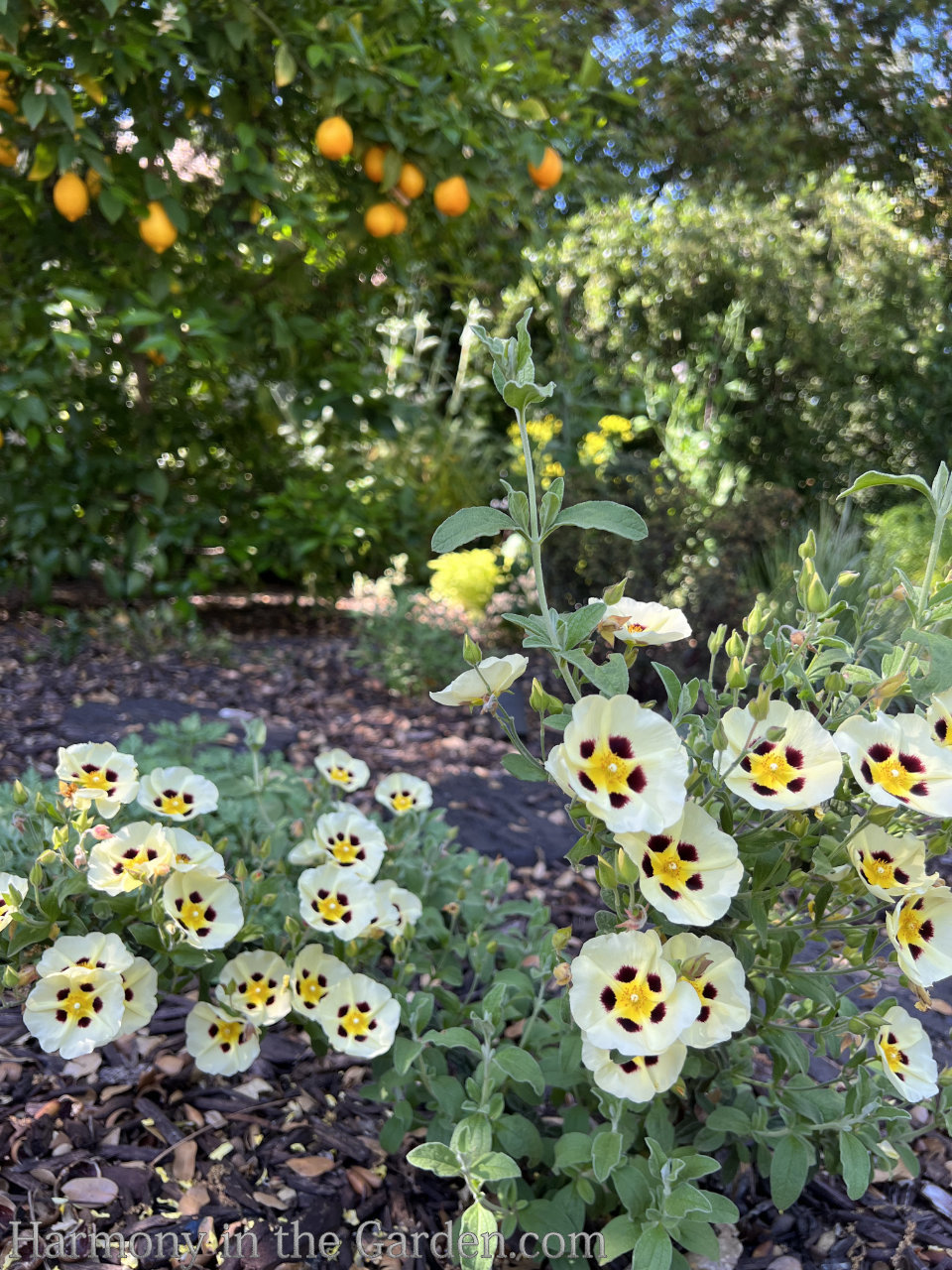
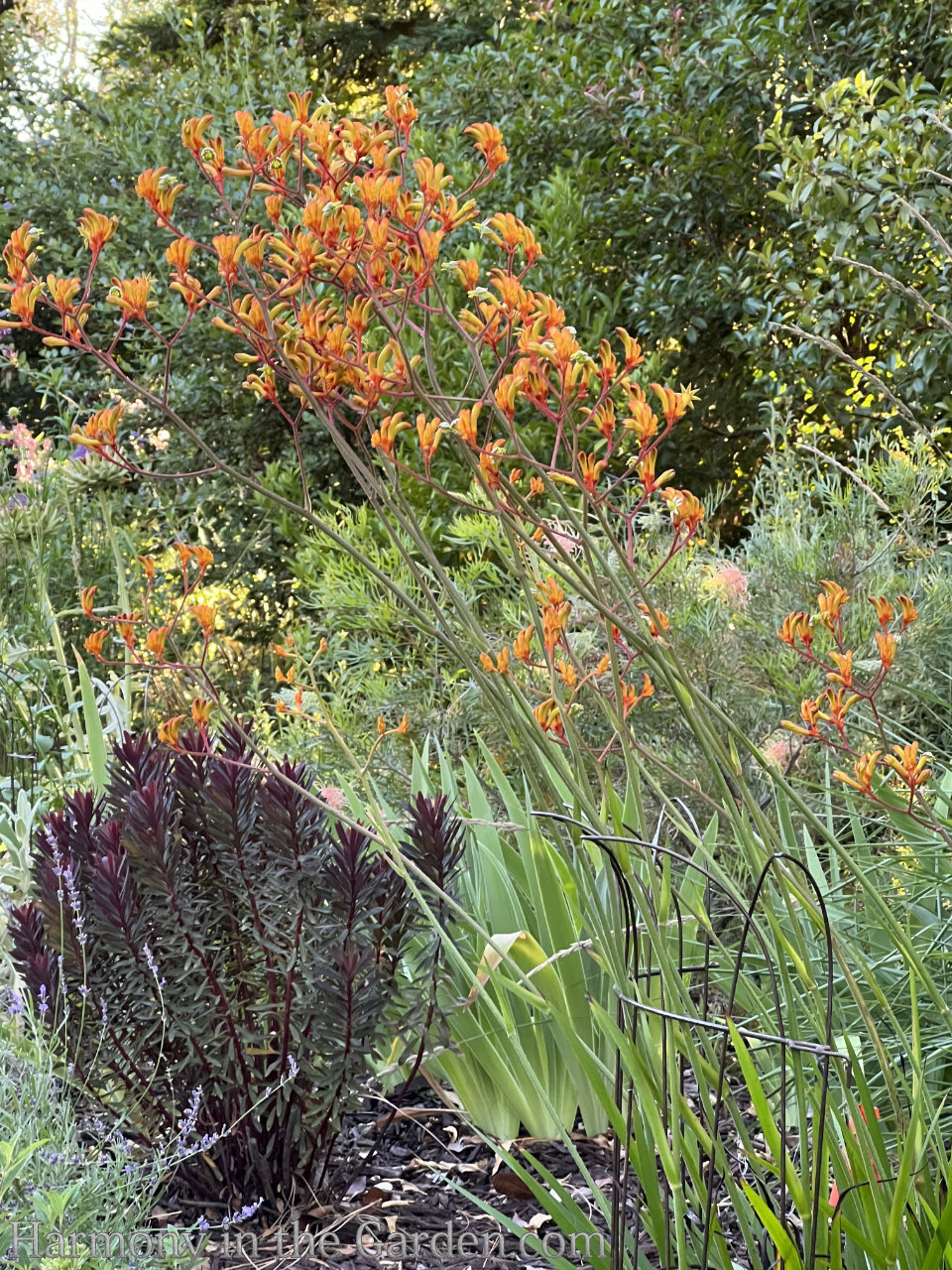
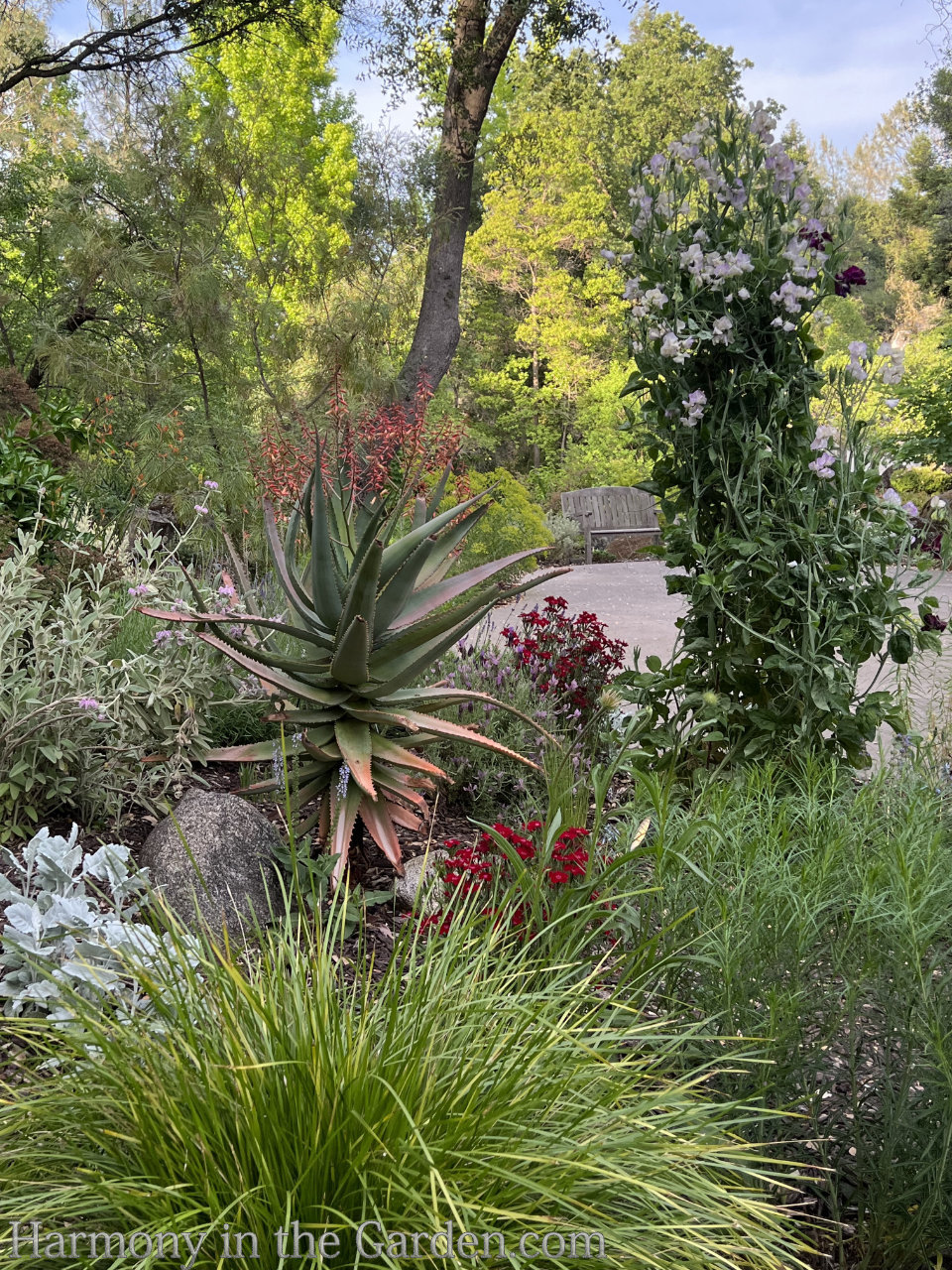

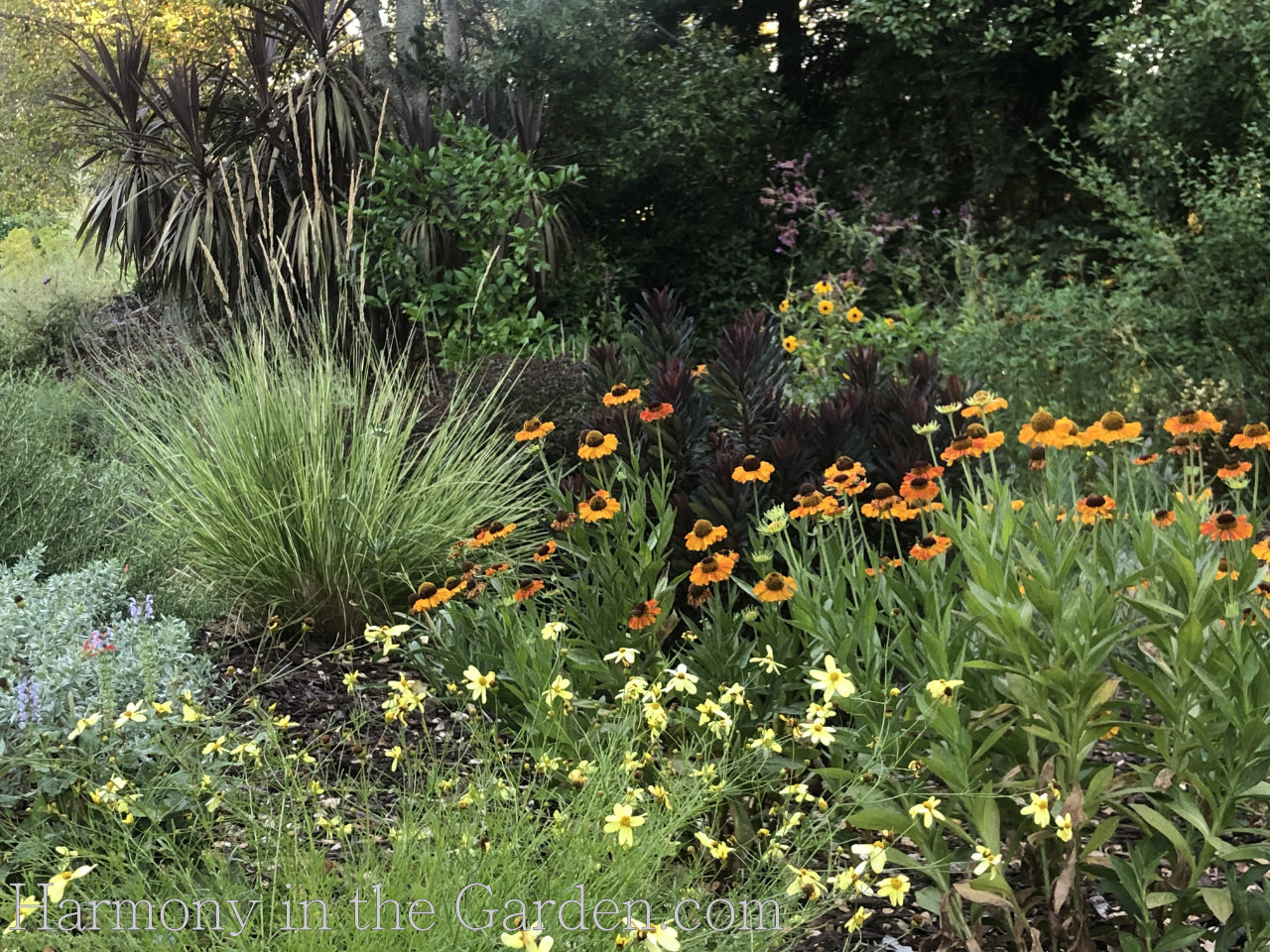

Design Challenge: Control the Chaos!
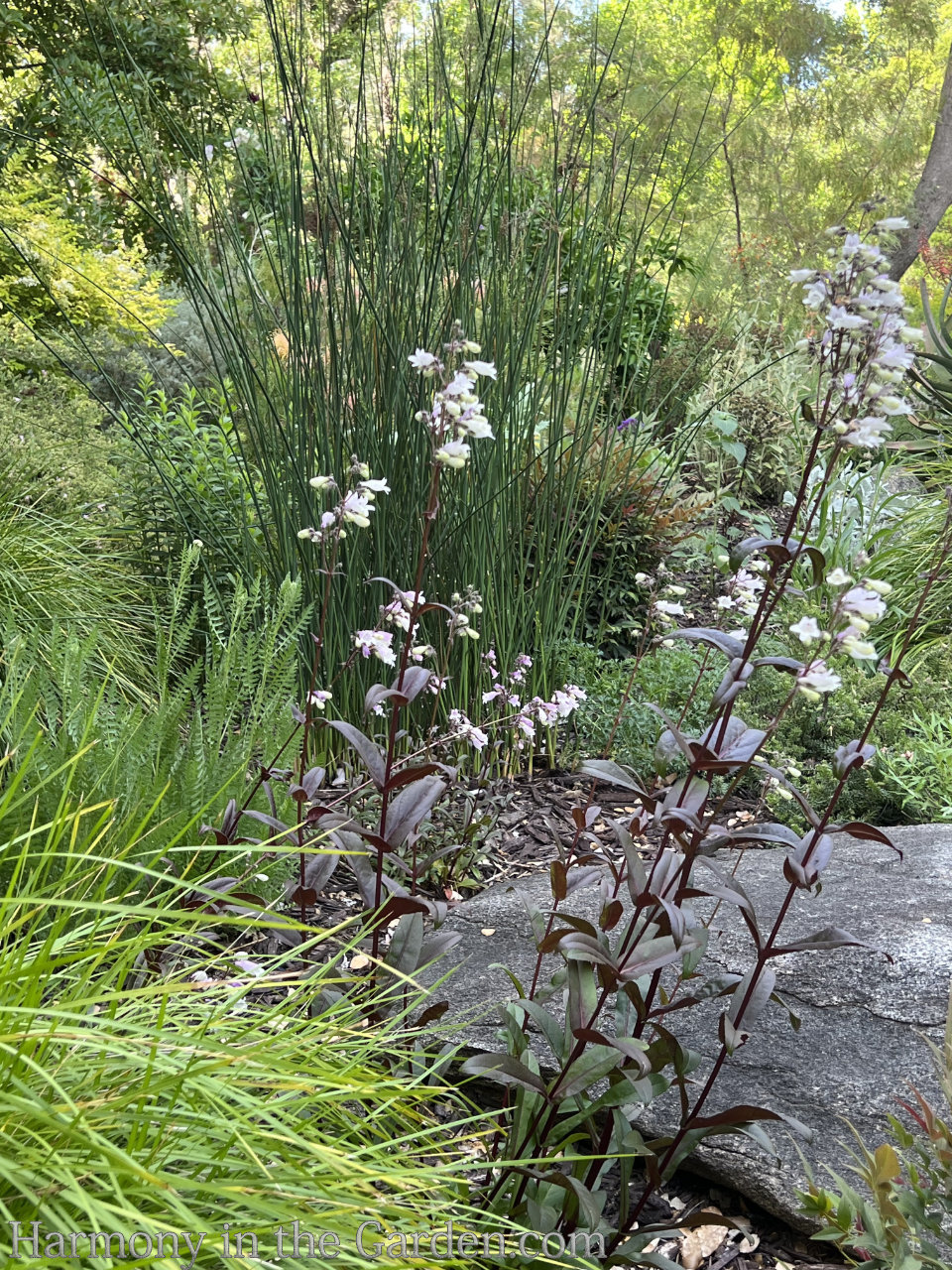
It’s common for meadows and prairies to consist primarily of plants with tall, wispy, and airy stems.
One of the reasons behind this shape is to help the plants withstand the constant whipping and drying winds.
Unfortunately, the result of so many intermingling plants with the same shape can often result in looking chaotic, weedy, and overgrown.
This is to be expected in a wild space – just not in my garden!
Here’s how I minimized the chaos:
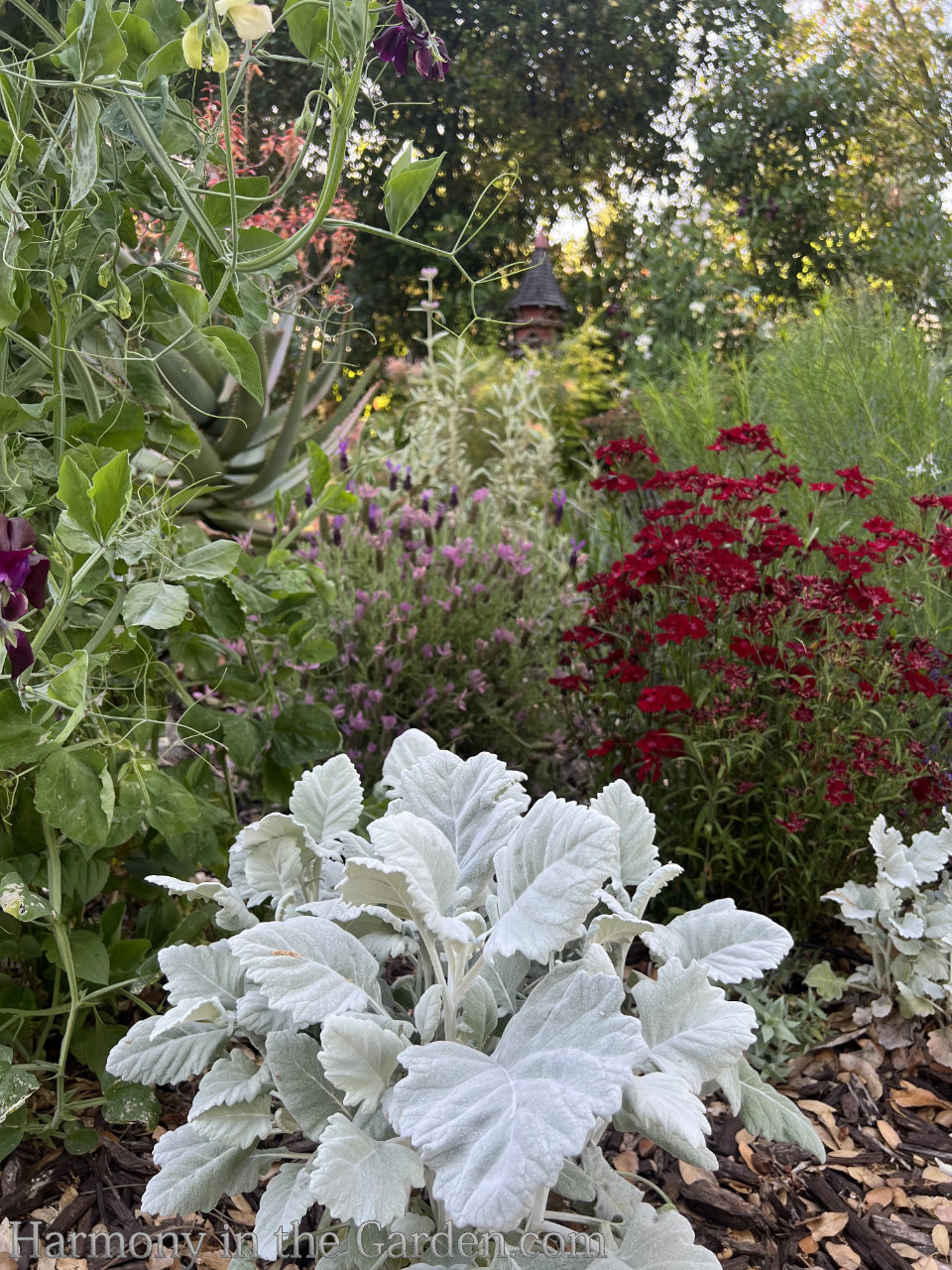
Incorporate Bold Foliage
To counterbalance the abundance of traditional taller and wilder-looking meadow plants, I included plenty of plants with bold and oversized foliage.
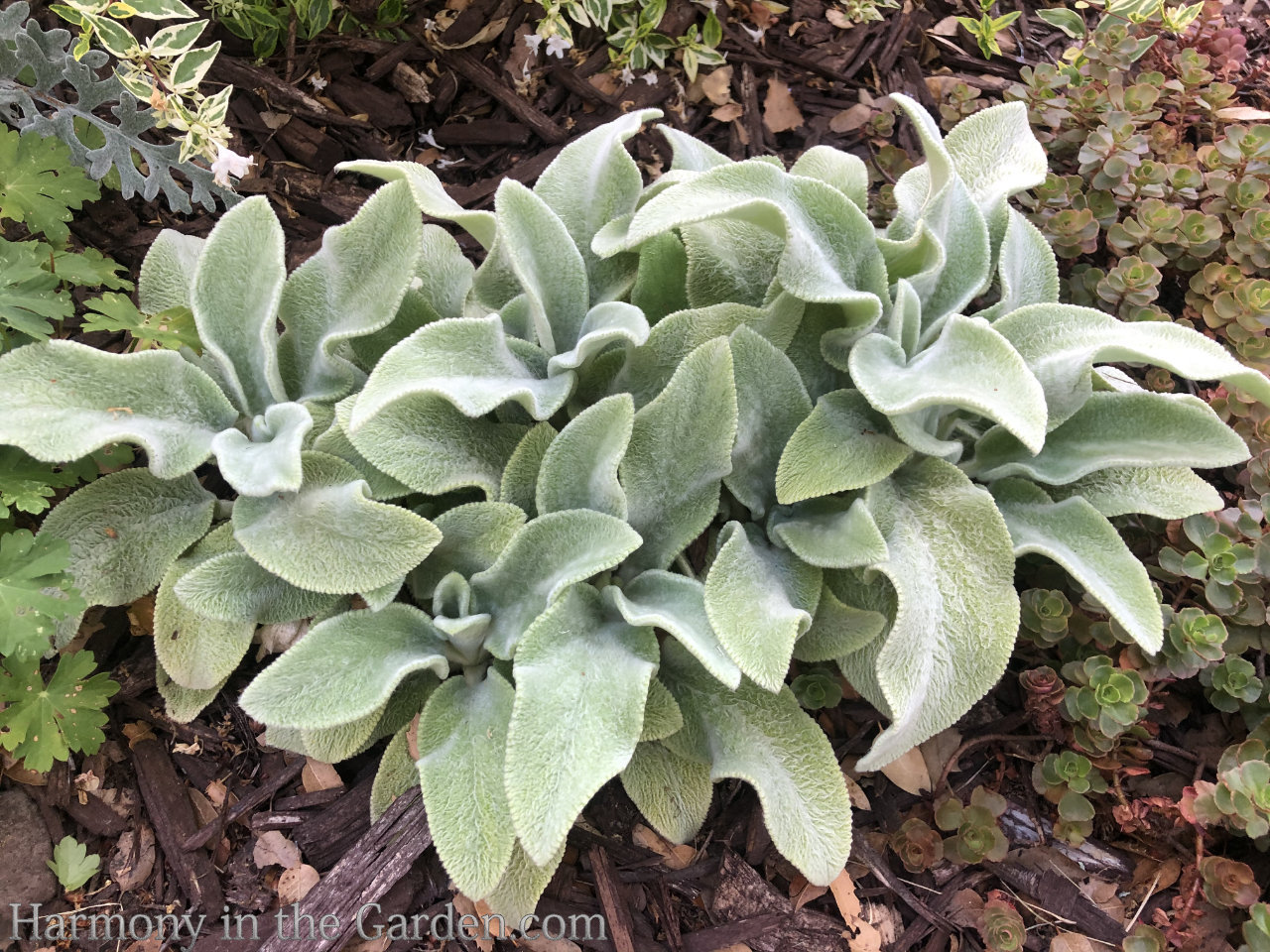
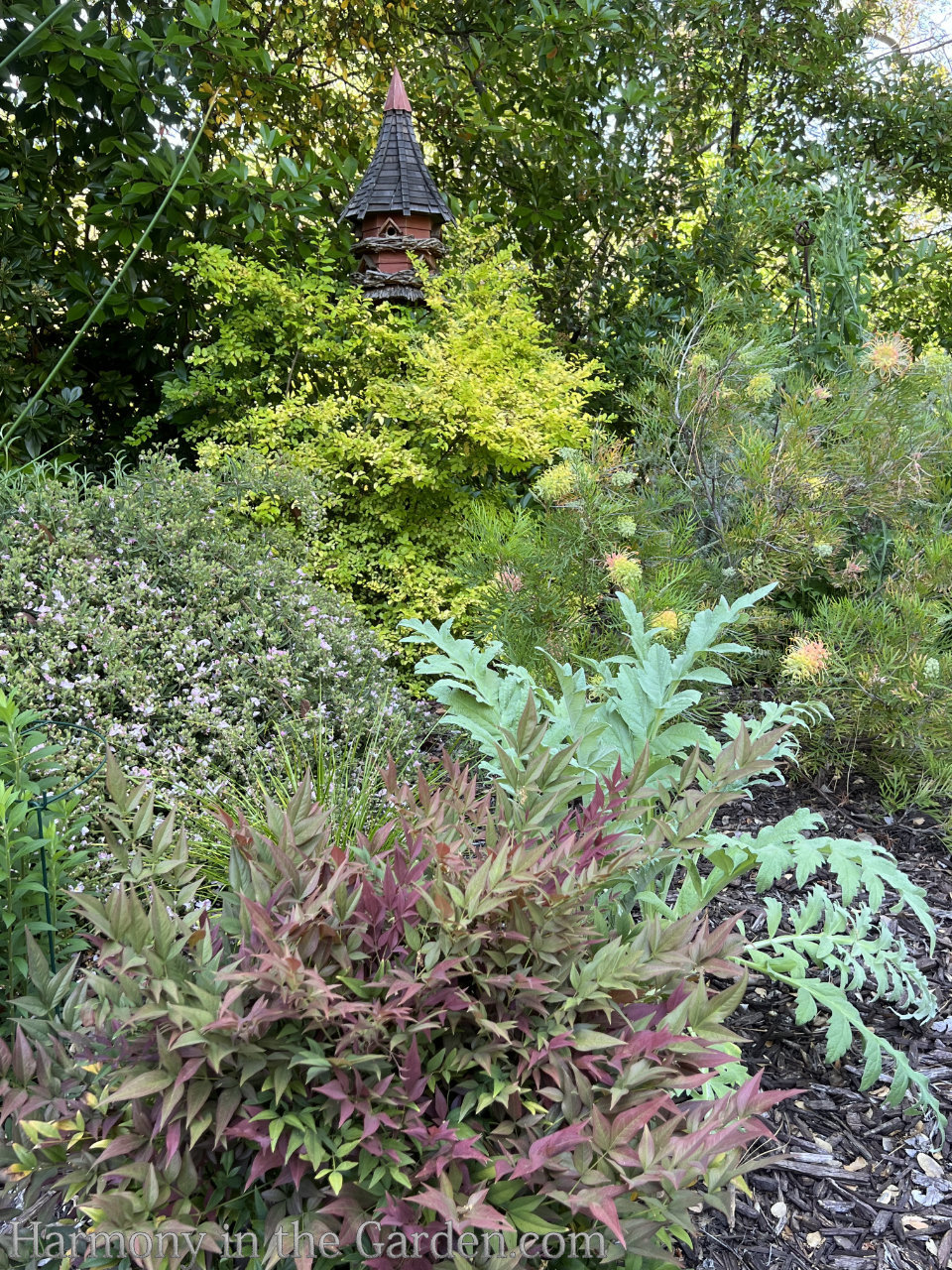
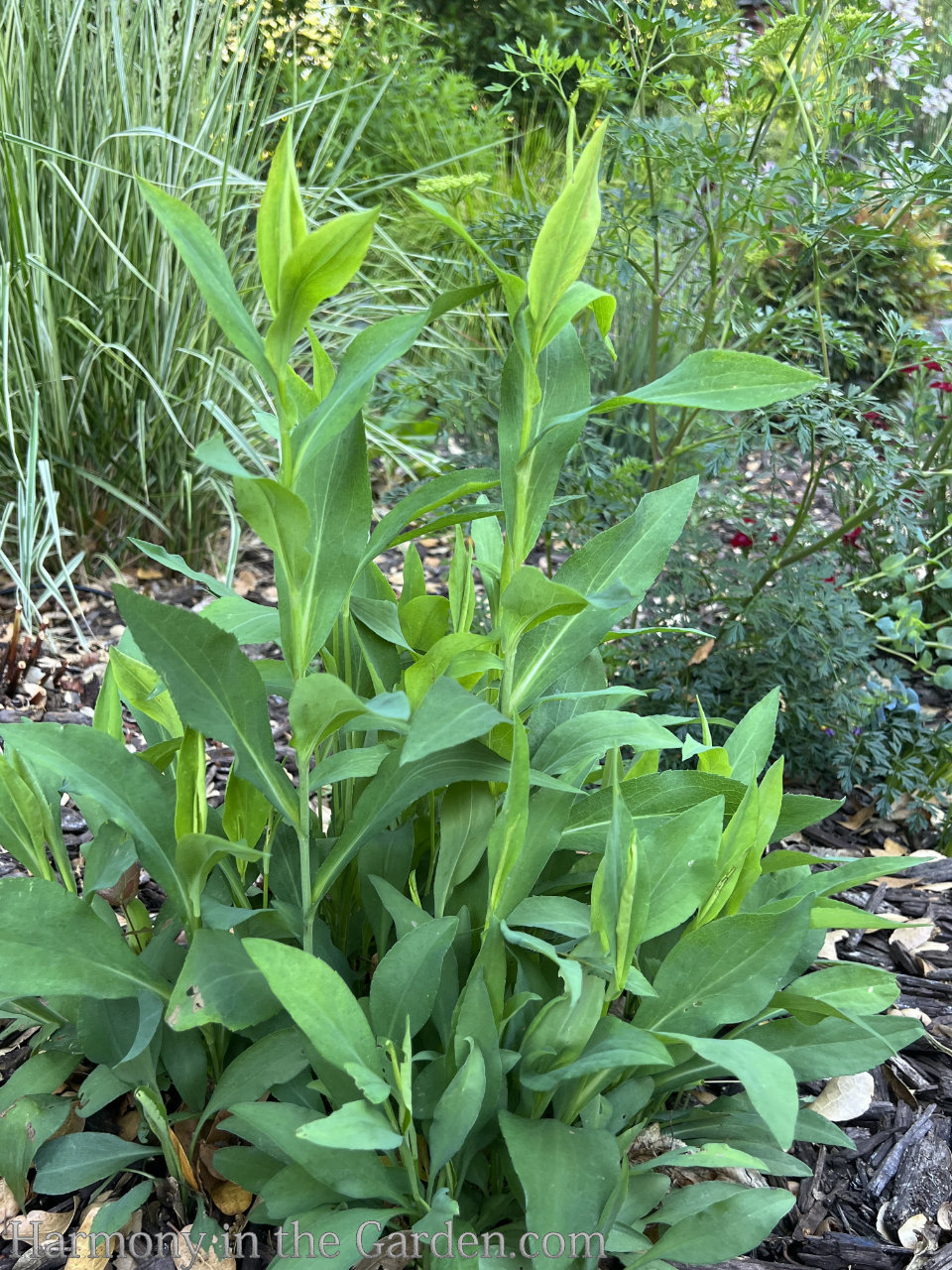
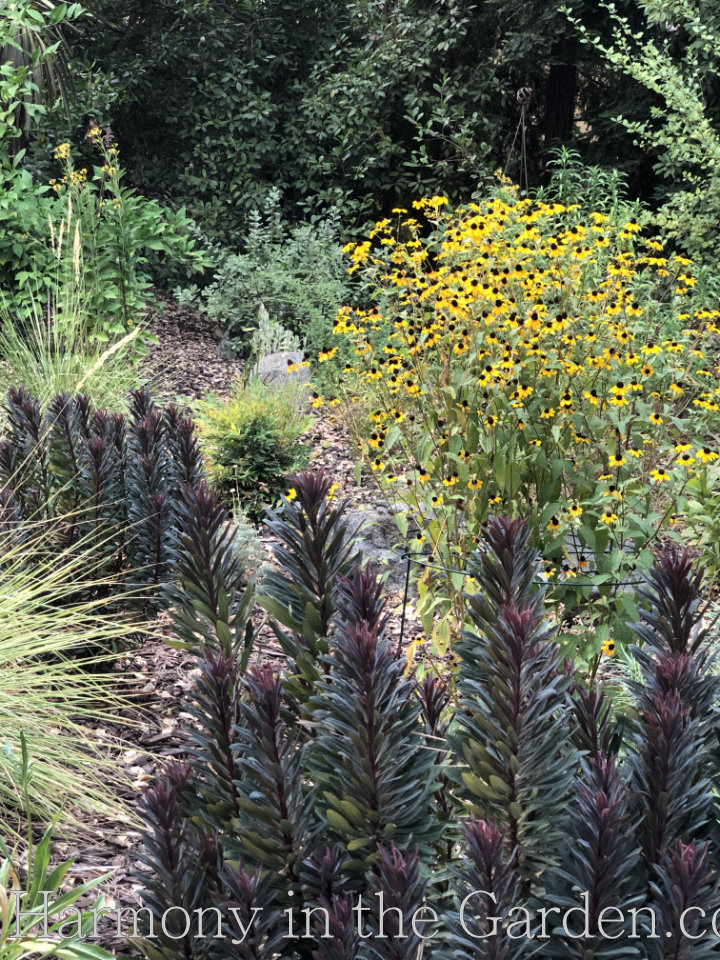
Add Plenty of Contrast
I also focused on contrast wherever I could, to prevent the overabundance of tall, wispy plants from blending into an uninspired ‘blob.’
In addition to contrasting foliage and flower shapes, I contrasted the garden’s layers, and even their bloom times.
Contrast is so important, in fact, that I’ve written a separate post all about the different ways to incorporate this design principle – click here to read more.
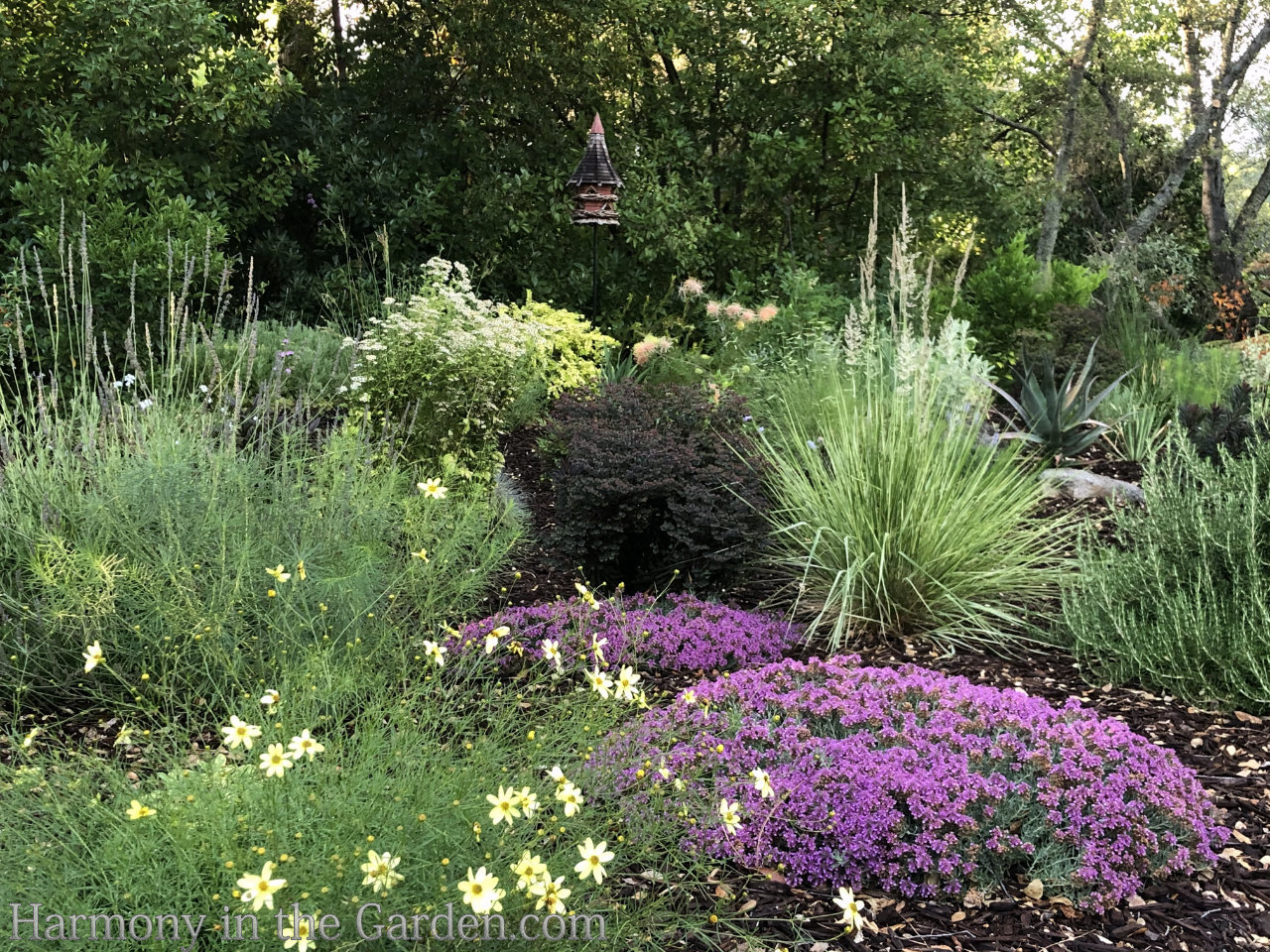
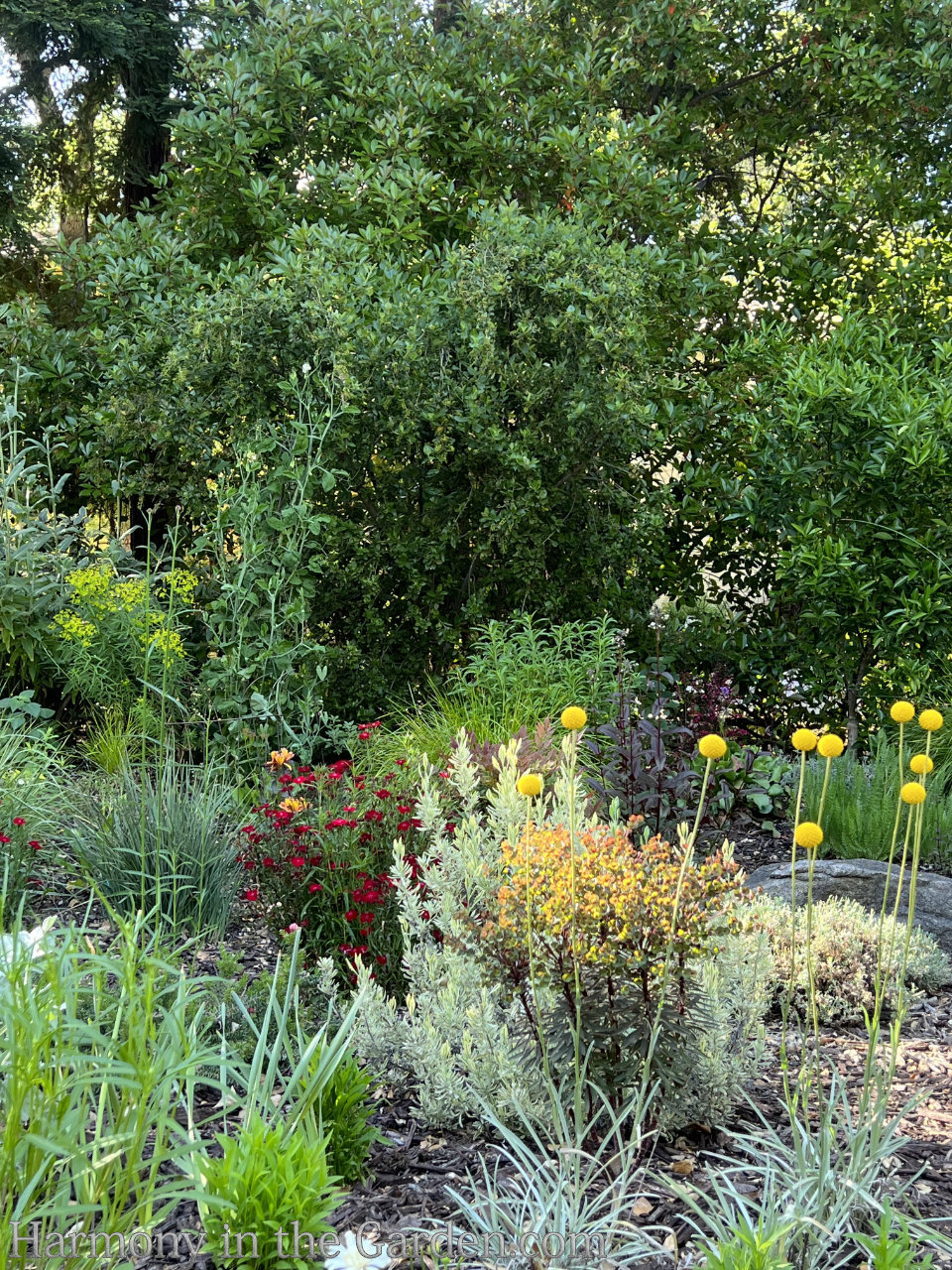
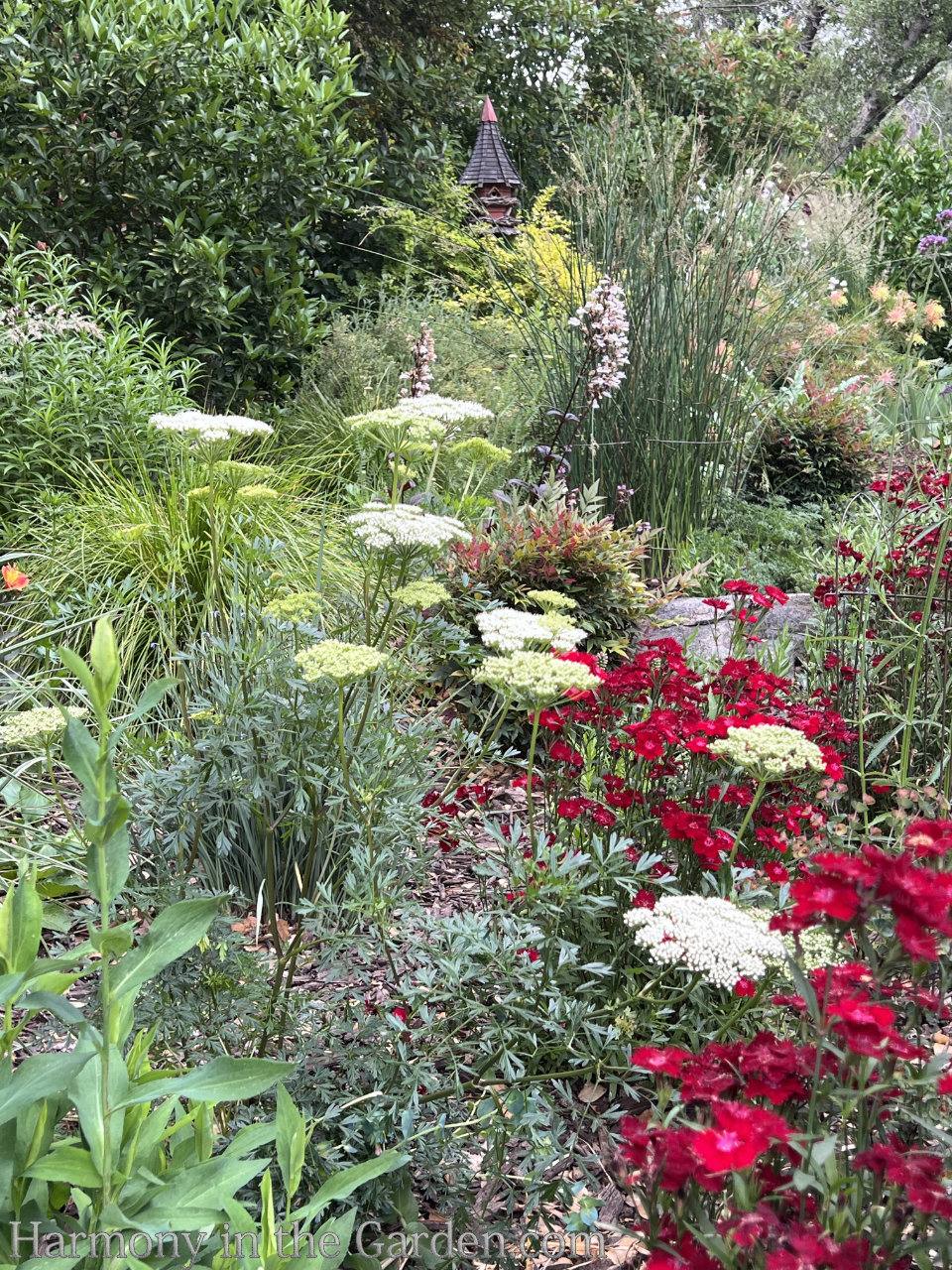
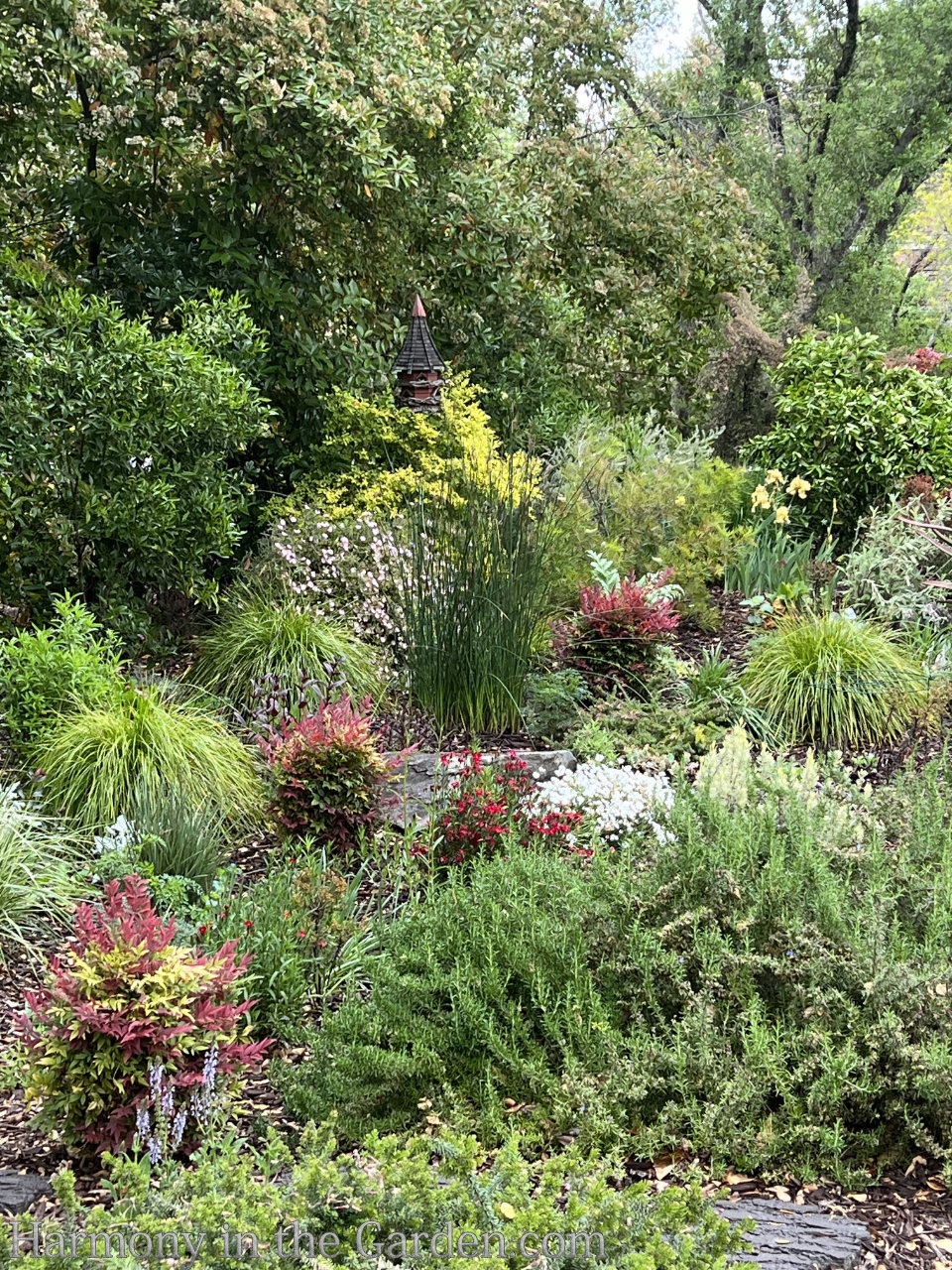
Unify with Color Echoes
When thinking of a prairie, images of the wind gently blowing through vast drifts of grass come to mind.
It can be challenging to create this effect in a small garden, so to achieve this I used smaller groupings of specific varieties (usually just three to five of one plant) wherever I could.
These smaller drifts or blocks of plants help to create a cohesive and expansive feel.
However, when you’re a plantaholic like I am, you want to use as many different varieties as you can (and not take up valuable space with drifts of one plant!)
To achieve rhythm and unity among so many different varieties, I focused on creating color echoes.
In this example (left and below) I linked several different plants together through the use of maroon and dark red colors (either from flowers or foliage.)
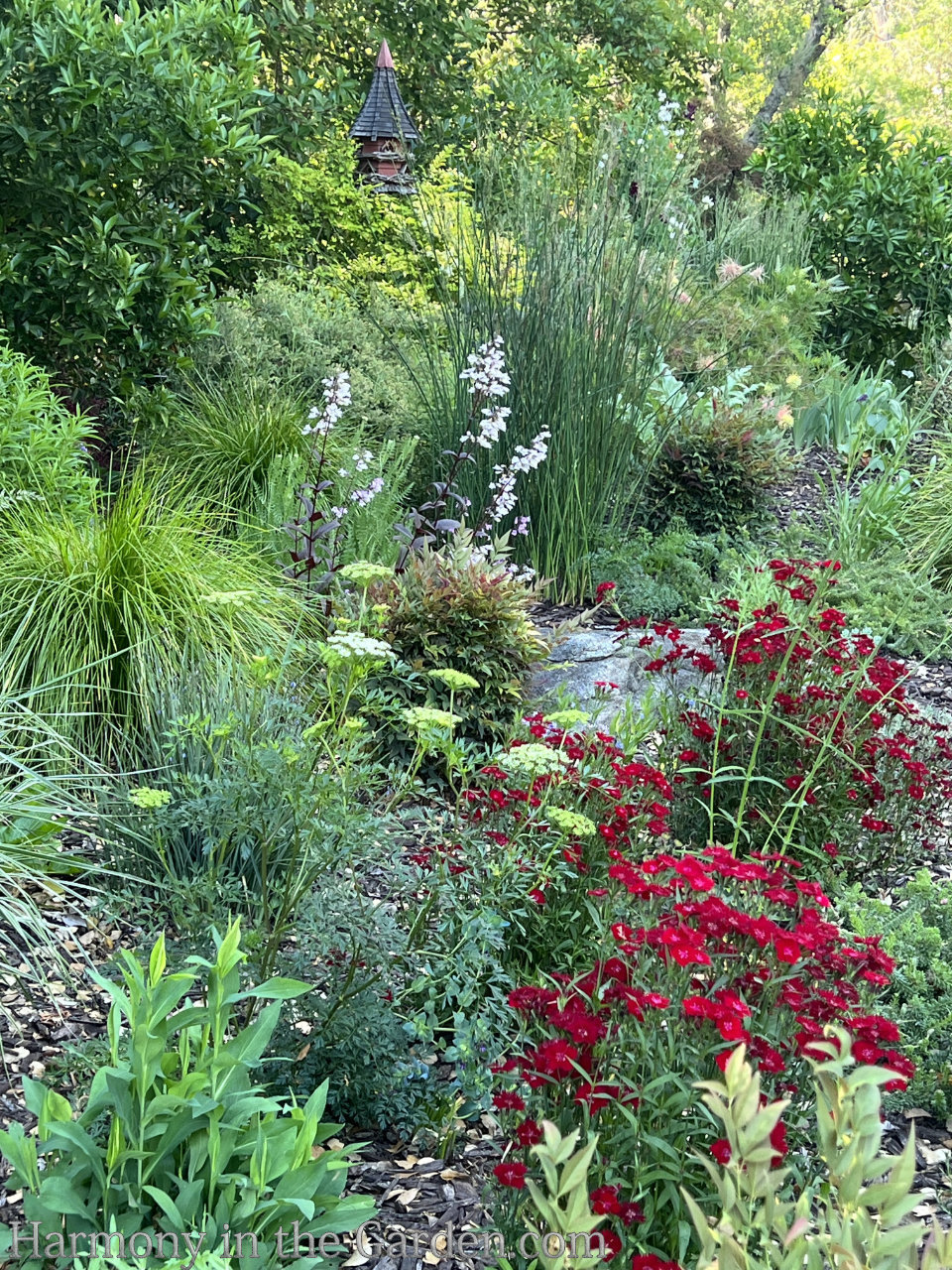
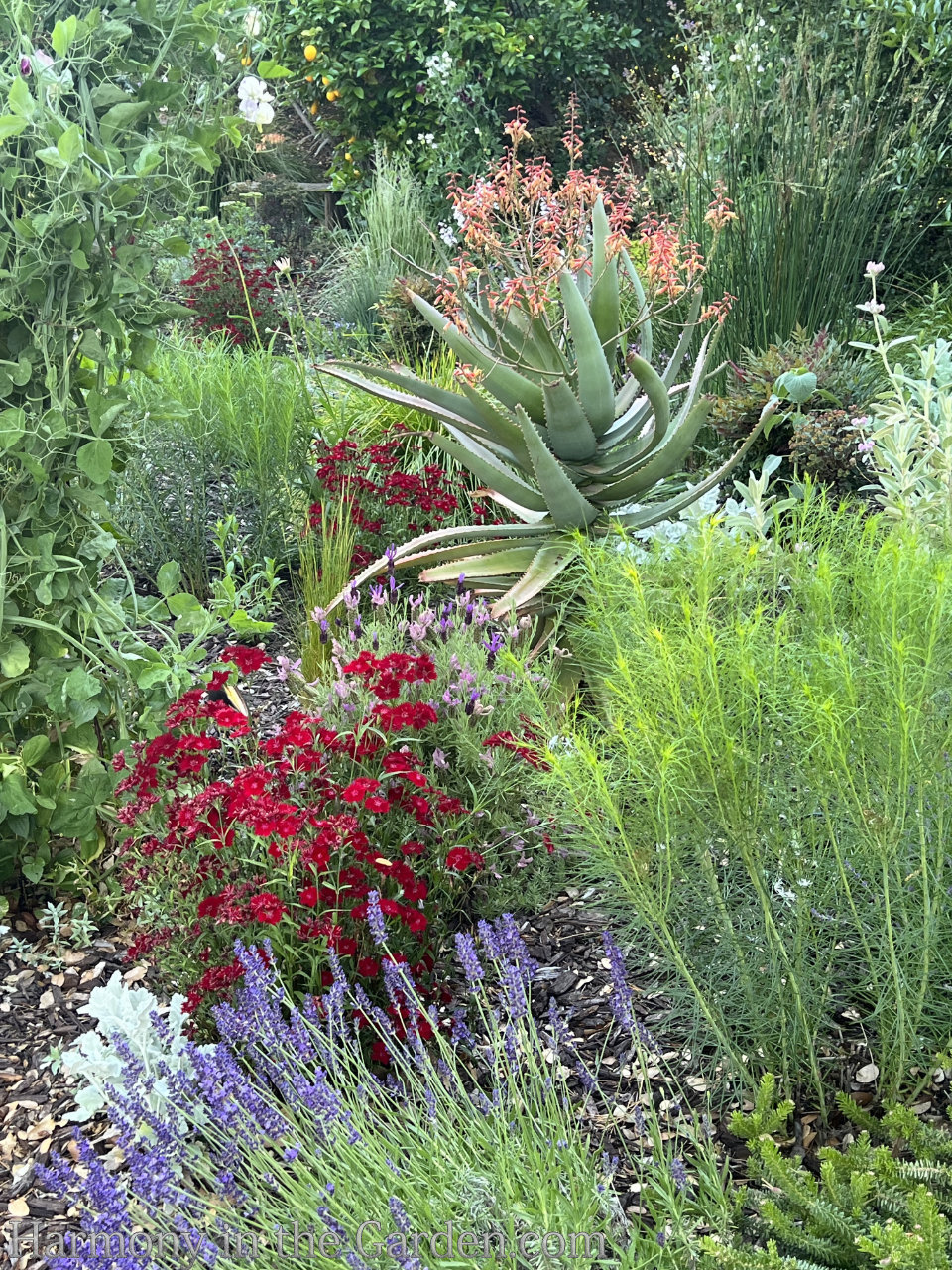
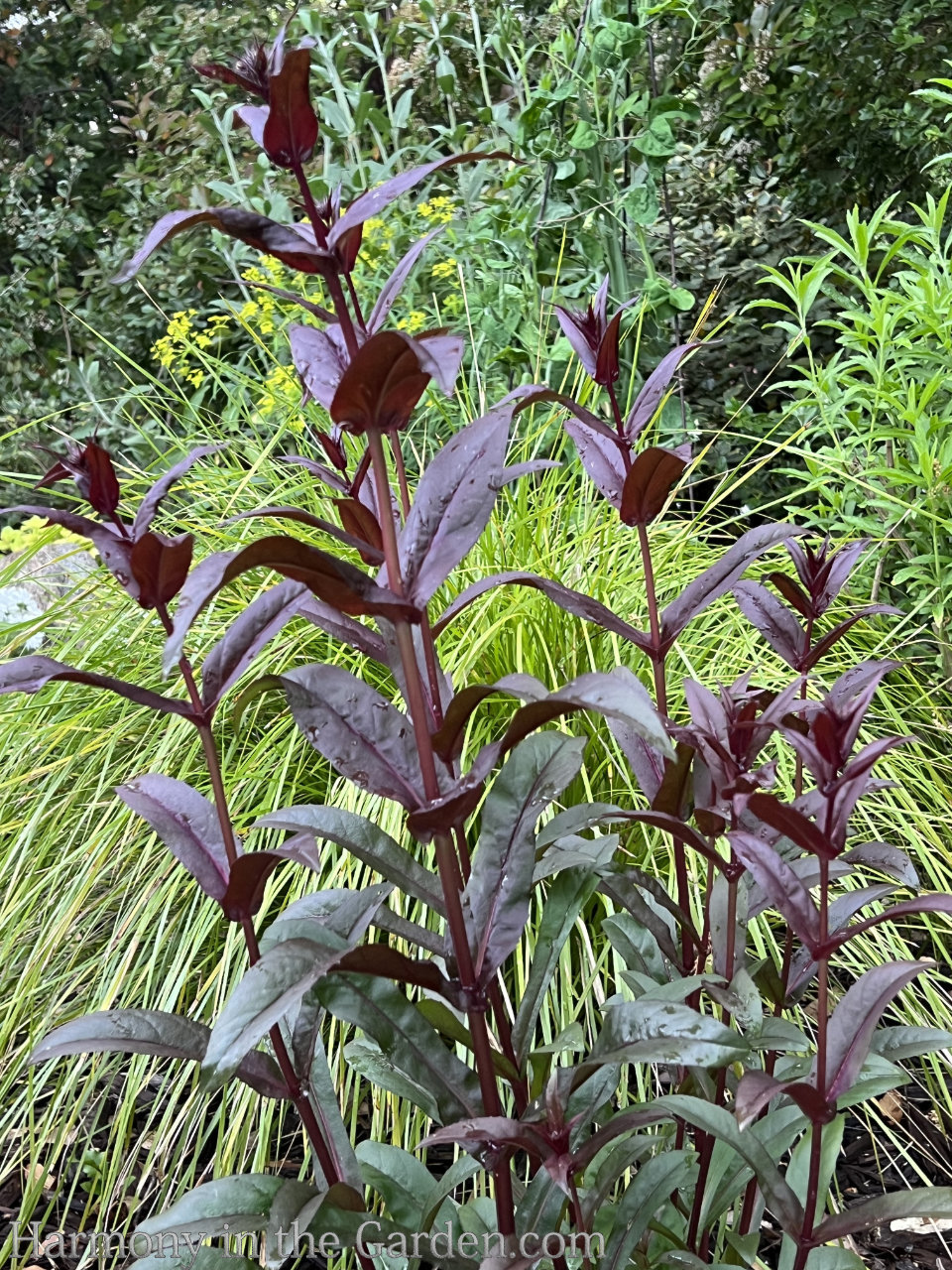
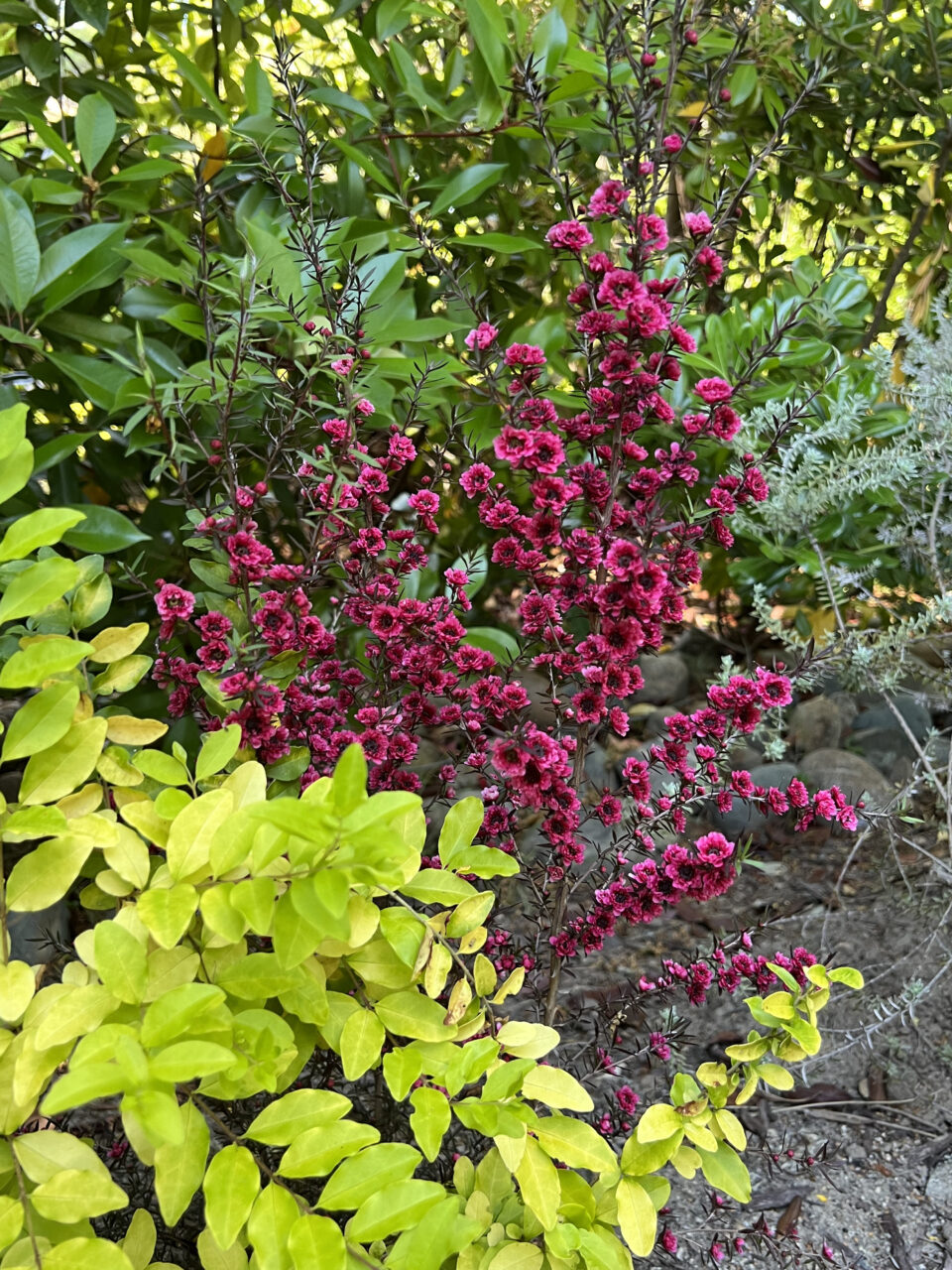
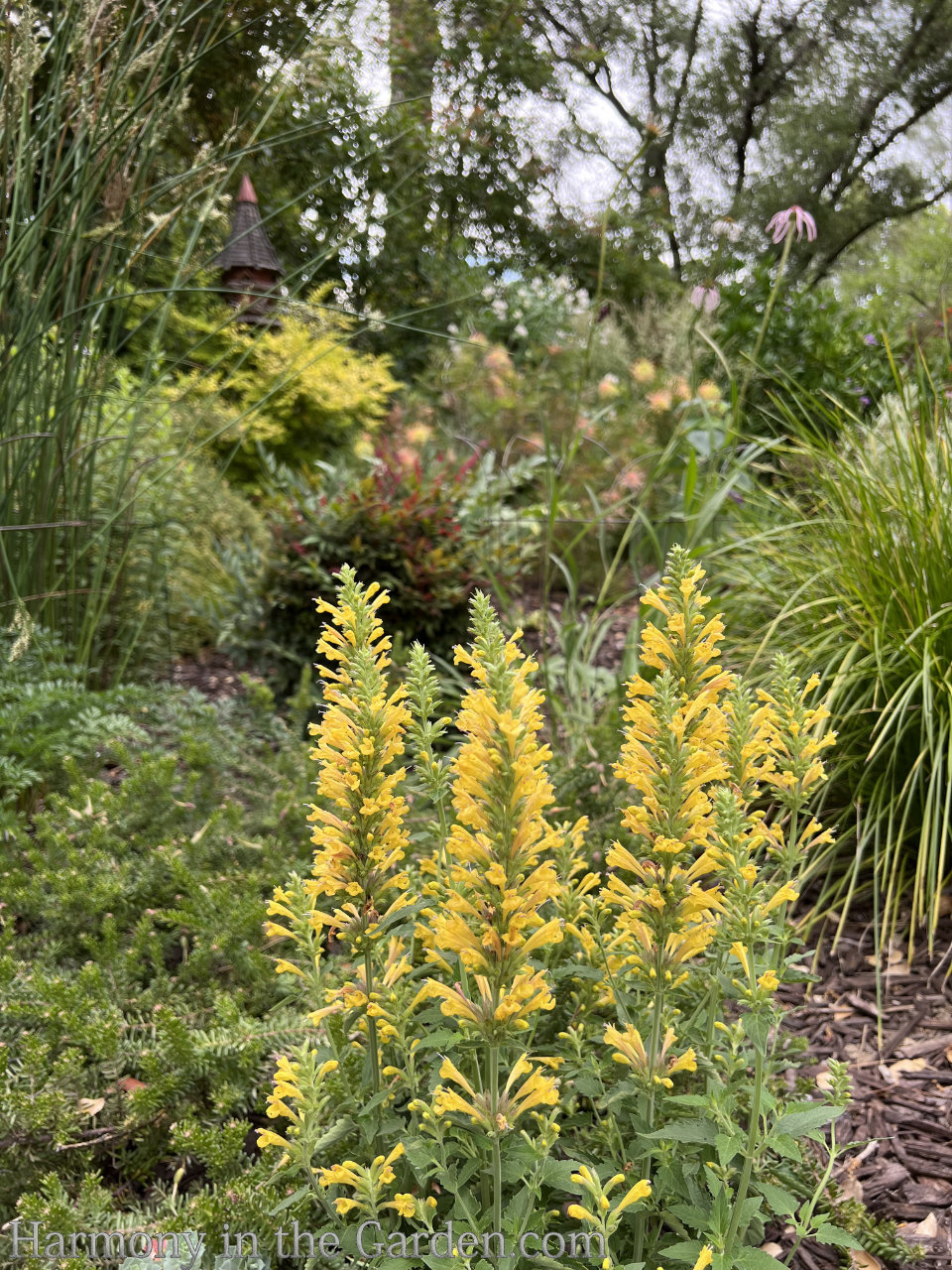
In this example, note how I used the soft gold/yellow colors to act as the ribbon of unity that flows throughout the garden.
Featured here are the soft yellow flowers of the agastache ‘Kudos’, chartreuse foliage of the ligustrum ‘Sunshine’ in the distance and the oversized flowers of the grevillea ‘Peaches & Cream.’
Creating color echoes can save the day, helping to tie together an overly busy garden!
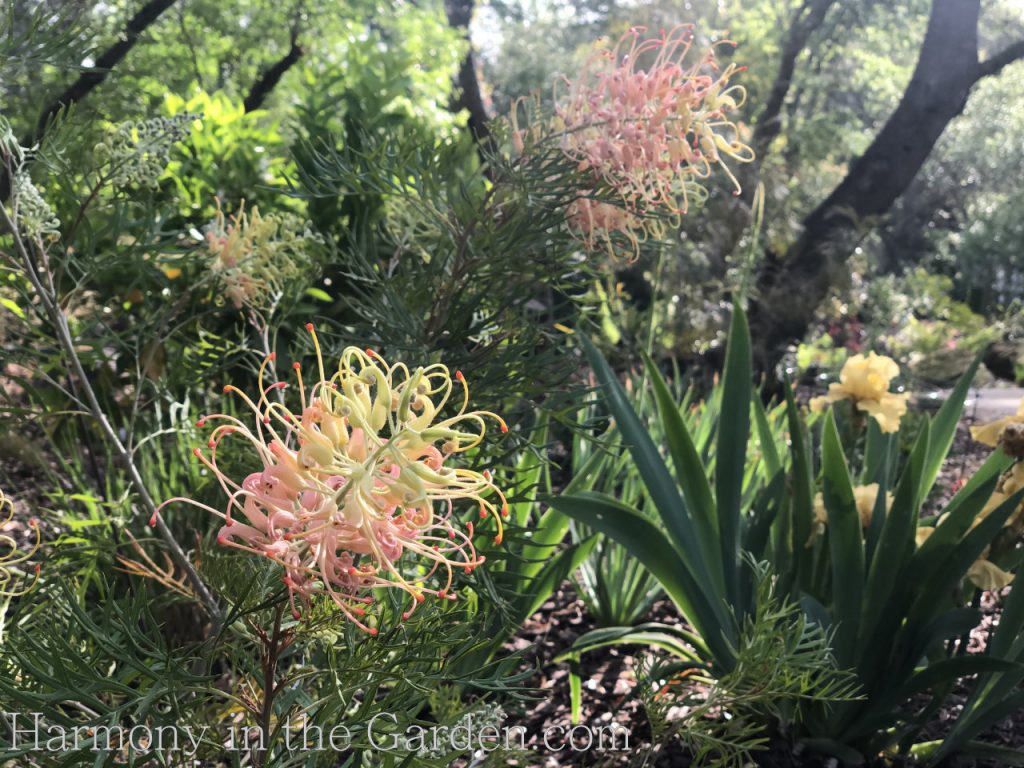
And now for my front garden tour – enjoy!
If you have any questions or comments, please include them below and I’ll be sure and respond!
But wait – there’s more! Take a look below for more information on removing your lawn and creating meadows:

For a deep dive into the specifics of removing lawns, I highly recommend one of my favoite books – Lawn Gone! Low-Maintenance, Sustainable, Attractive Alternatives for Your Yard
You’ll learn about pros and cons for various ways of eliminating lawn, lawn alternatives, and inspirational photos. (spoiler: one of my gardens is featured in this book!)
This next book, Gardening in Summer Dry Climates – Plants for a Lush, Water-Conscious Landscape , was written by Saxon Holt and Nora Harlow.
Even if you’re not familiar with Saxon Holt, you’ve undoubtedly seen many of his photographs in various garden books and magazines. He’s not only talented but passionate about low-water gardens.
And finally, if you’re interested in creating a meadow garden, I highly recommend reading The Meadowscaping Handbook (it’s free, too!)
Even though it’s written for the Pacific Northwest, there’s a TON of super helpful information and links that can be applied throughout the country, no matter your zone.
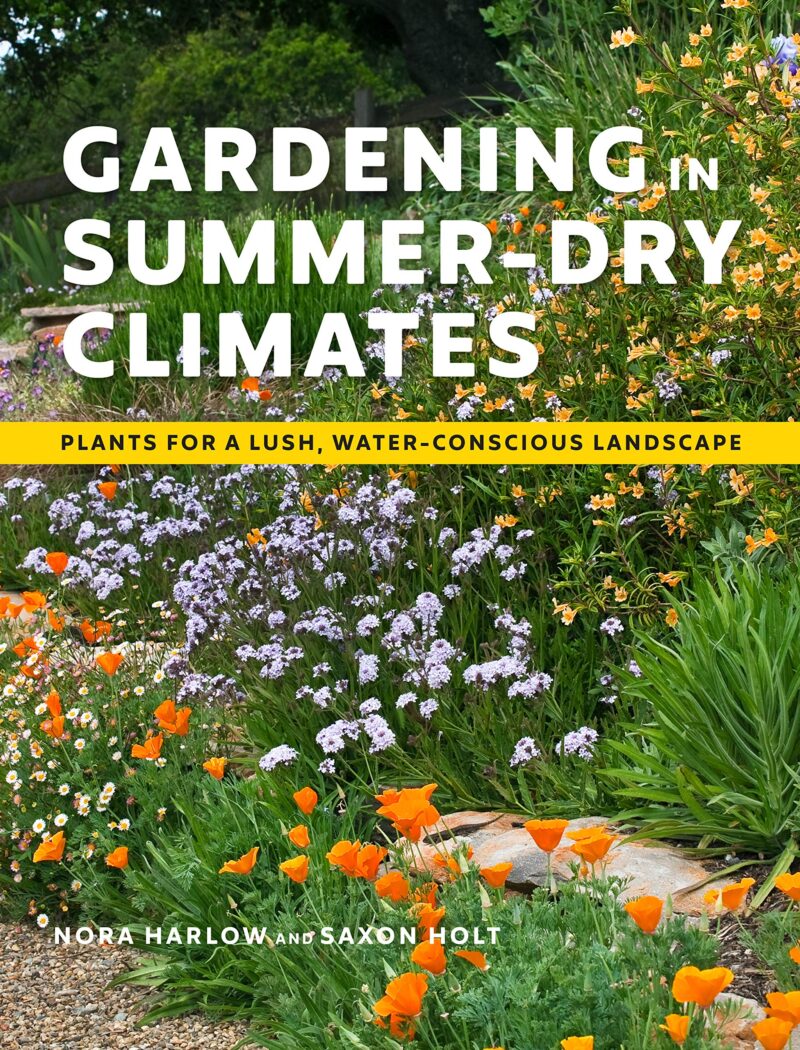






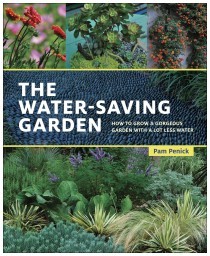
18 Comments
Rebecca, all the plants are so wonderful! Thank you for sharing.
You’re so welcome, glad you enjoyed my post!
I loved watching the video and learning how you created all the beautiful areas. I notice that you haven’t used much of the native California plants. Is there a reason why you didn’t plants any plants local to the area?
Hi Sujatha – so glad you enjoyed the video and post. I actually use a lot of natives and featured a few (ceanothus, penstemon, asters, zauschneria, etc.) with a link to many more that I plant throughout my garden. I’m certainly not a native-only gardener as I love all plants and my goal is to experiment with as many as possible (native or not) to see what can thrive in my super hot climate with deer, no less. As I mentioned in the video, this garden is my ‘grand experiment’ with wins and losses, and my goal is to share my results with my readers. I’ve found that many of the native plants that I like do better with a little afternoon shade, which this area definitely doesn’t get. Here’s a link if you’d like to see more natives that I have in the garden: https://harmonyinthegarden.com/2021/04/my-top-30-native-plants-for-the-garden/
I recently discovered your website and insta, loving the content so much! Where do you typically buy your new plants? I’m in the East Bay so I love Alden Lane but I’m on a Home Depot budget =)
Hi Linda, thanks so much and welcome! 🙂 Honestly, I buy my plants anywhere and everywhere as it seems certain places tend to have different things. If you go to the homepage of my blog, on the right side, towards the bottom, I’ve listed some of my favorite sources (both retail and online) though that’s really just a drop in the bucket. In the East Bay, I love Sloats in San Rafael (my daughter lives there so I visit that nursery a lot) and Annie’s Annuals and the Ruth Bancroft Garden (your neck of the woods). And believe it or not, the Home Depot in San Rafael has an amazing nursery department (like none other I’ve ever seen at a big box store.) I’m not a huge seed-starter, but when I do I love Renee’s Seeds. Though I just ordered a few varieties from Swallowtail Garden and Floret Farm, as Renee’s didn’t have the ones I was looking for. I also start a LOT of plants from cuttings which has been a fantastic way for me to get the exact variety I want (seeing as so many varieties aren’t available any longer, like the ‘Mozart’ rosemary which I LOVE, etc.) While it’s expensive to order online, that’s usually the only way I can get the plants I want so I’ll either try and order a lot to avoid shipping charges, or wait until they have a sale (like now, I believe there’s a fair amount of online sales happening.) Also, if you’re interested in propagating your own plants you should definitely check out https://www.instagram.com/anya_thegarden_fairy/ – she has awesome videos. Good luck!
This is certainly very ornamental, and I’d like to see a plant list. As a landscape contractor in El Dorado county for 20 years (I live about 50 miles from you), I have come to specialize in California native plants. You mention native plants at the beginning of your article, but I only see a few labeled that I recognize..
Hi Verne – Nice to hear from you! I have too many plants to list them all and only focused on the ones blooming now (or recently have been blooming) For a list of my favorite natives, click on the word ‘native’ (it’s highlighted in blue) and it’ll take you to a list of 30 or so natives that I have throughout my garden. Lots are in this section of my garden but weren’t quite yet blooming (asters, for example, of which I have tons! In fact, if you type in ‘aster’ or ‘salvia’ in the side search bar, that too will take you to lists of the varieties that are in my garden.)
Just beautiful! You are a remarkable gardener Rebecca. My cutting garden is looking really good this year due to the rain and the fact that I am now mostly only planting perennials in it which means it is not as much work each Spring. I have a new project in one area of my backyard because I took down my three redwoods back in the corner. I have not planted yet….thinking and thinking of just one tree for the corner before I decide on the plants. I always gather good ideas from these newsletters. My circle in the front that you designed is looking lovely. It is my little corner of woodland. Thanks for that design and today’s video.
Hi Sylvia, thank you so much (and, I’m glad to hear your front circle is still looking great!) I have several redwoods along the perimeter of my garden and their roots are just so awful, aren’t they? How nice that you have a new area to plant without those dense mat-like roots invading every new space.
very inspiring. Question: do you have deer or gophers? I have both and am wondering how your garden would survive
with those two visitors.
Hi Jolie, yes I have deer that visit my garden and so far my garden has had minimal damage (knocking on wood!) The plants I use are fairly deer-resistant, though I may have occasional munching on young deer who are testing things out and/or really hungry deer in the late fall. Gophers, however, are a whole separate issue and luckily I don’t seem to have any. They’re so destructive, even putting gopher cages around the root-balls when planting isn’t 100% effective.
Dear Rebecca: You have done a beautiful job with you “pseudo” meadow. the choice of plants give me lots of ideas even for Mill Valley where I garden in the sun. I have several Lomandras which tend to get too big after only a few years. Have you ever hard pruned them and did they rejuvenate? Thank you as always for your happy blog. Diane
Hi Diane, thank you so much! My daughter and her fiance just bought their first home in San Rafael and have a large garden where I can vouch for the plants in my garden surviving in their garden (they’re in the hot, full sun also.) I give them tons of cuttings and divisions of my favorites, so they should do just fine in Mill Valley. Those lomandras certainly get huge (I’m specifically referring to ‘Breeze’ and ‘Platinum Beauty’) but there’s a few other varieties that grow smaller. Unfortunately, ‘Lime Tuff’ and ‘Del Sol’ are incredibly hard to find (at least in my area) so my wholesaler has been substituting those with ‘Pom Pom’/’Shorty’ which grow to about 20″x20″. You might give those a try if you have another spot. You can cut your overgrown lomandras hard, down to about 8″ or so, and they’ll regenerate with healthy new blades of grass. There’s lots of Youtube videos that show how its done. In my experience, they don’t re-grow super fast, but if you’re patient they’ll look like a lovely, lush, and healthy lomandra soon enough.
I am fighting a weed, Galium aparine, or better known as bedstraw. Do you know of a good way to get rid of it. Love reading your articles. Thanks
Hi Judith, my garden also has those pesky, sticky weeds and this time of year (after they’ve had time to mature) they’re harder to remove without having them get stuck all over my gloves and dog’s fur. In the early spring, I try to pull them out while they’re young, before they’ve had time to get super stickery, but even so I can almost guarantee if I went outside right now there’d be several growing, just waiting for me to walk by so they can attach themselves to my socks! Other than vigilant hand-pulling, I don’t have another herbicide-free way to remove them. I did, however, find this interesting article about them (did you know they’re edible?) https://www.bbg.org/article/weed_of_the_month_cleavers Glad you enjoyed my post!
Your tour video found me on YouTube and I was so giddy seeing your garden and this post. I live in Phoenix, AZ on a flood irrigated lot that gets runoff water 1/month in winter and 2/month in summer. Flood irrigation is amazing but it’s an unusual situation. Gardening guides for arid climates or Phoenix generally assume drip systems or decomposed granite. Your post was the ONLY one I’ve found where I felt like “This! This person is figuring out what I’m hoping to figure out!” I’ve been searching for new perennial gardens that were for hot, dry climates and hadn’t had much luck. I feel like I won the lottery finding you!
I’’ve been slowly replacing more of my Bermuda grass (😖) with more perennials and natives. I’ll check out your suggested resources. Thank you for sharing your knowledge and garden. It’s been a fun but huge learning curve trying to figure out what will work.
I’m Sunnyslope Garden on Instagram. If you’re ever in Phoenix, you’re welcome to visit.
Hi Leslie- I’m so glad you enjoyed my post! I can relate to the ‘huge learning curve’ you’ve been going through as it’s been a lot of trial and error for me over the past few years to figure out what can survive our summers without a lot of water. I do, however, have to water my garden with drip irrigation, but the trick for me has been to keep my water usage as low as I can without killing my plants. I definitely make my plants work for it – no coddling here! Mulching regularly really helps lock in the moisture, and each year I try and add a bit more here and there to make sure there’s a constant layer of 2-3″ deep. I’ve been amazed at how much moisture is retained with a thick layer of mulch. But mulch can only do so much and when August arrives the soil is bone dry and that’s when things start to get a little dicey out there! During the 110+ heat waves I’ll give my plants a little extra water to get them over the hump, but that’s about it. I’m so amazed at your instagram pics as we seem to have a lot of the same plants (including my favorite rose ‘Lady Shallot’) and can’t believe how beautiful your garden is! Great job, it looks amazing!